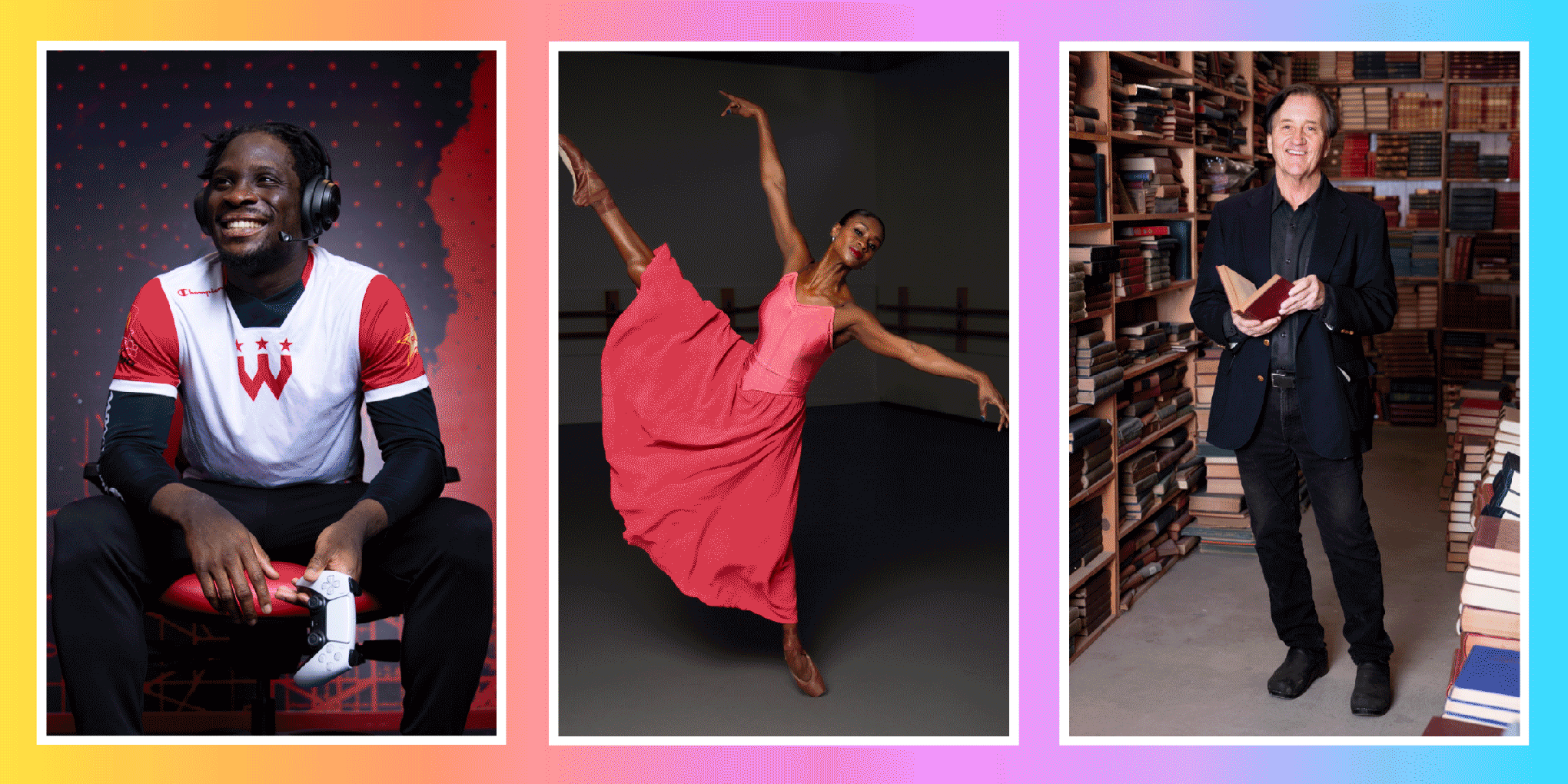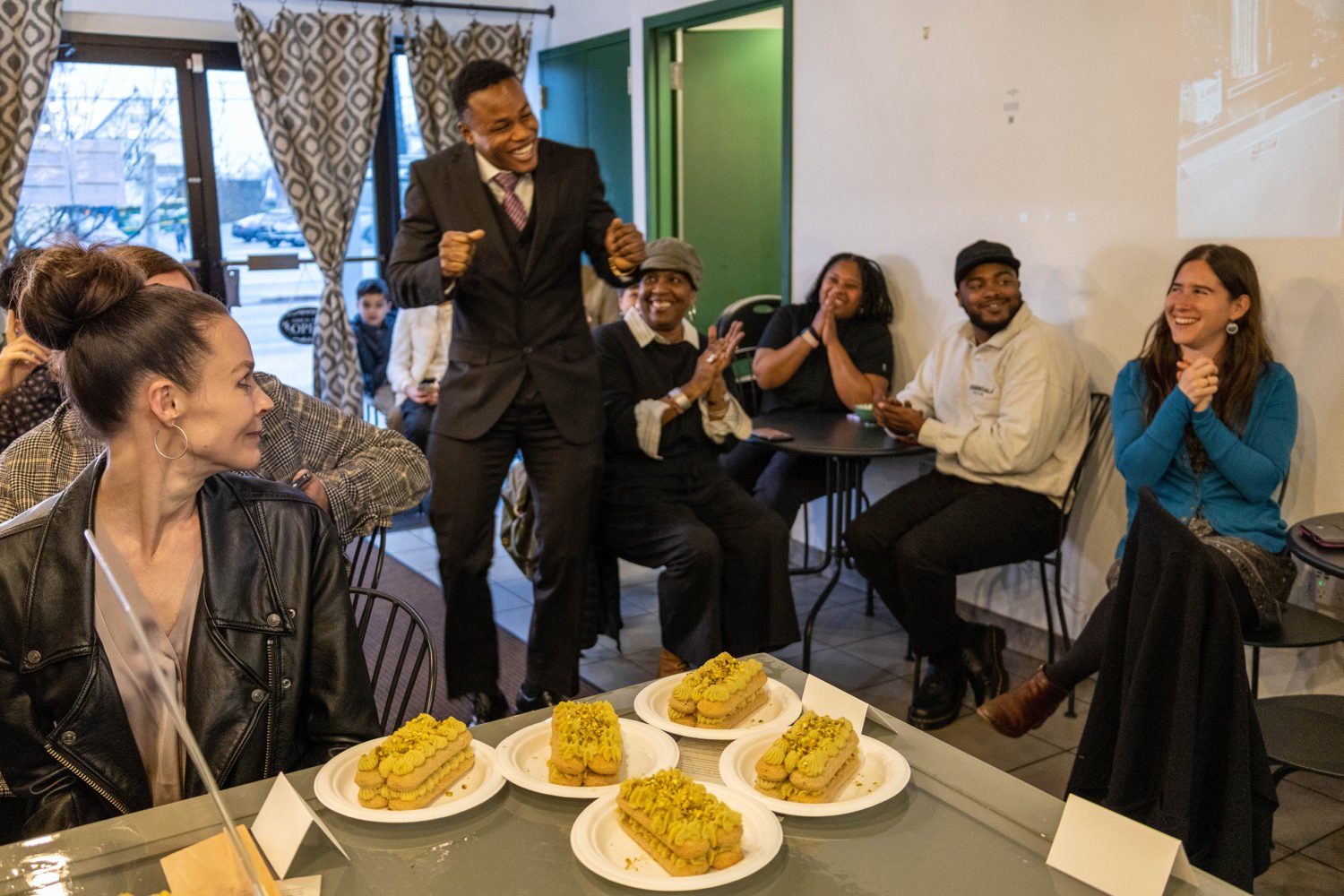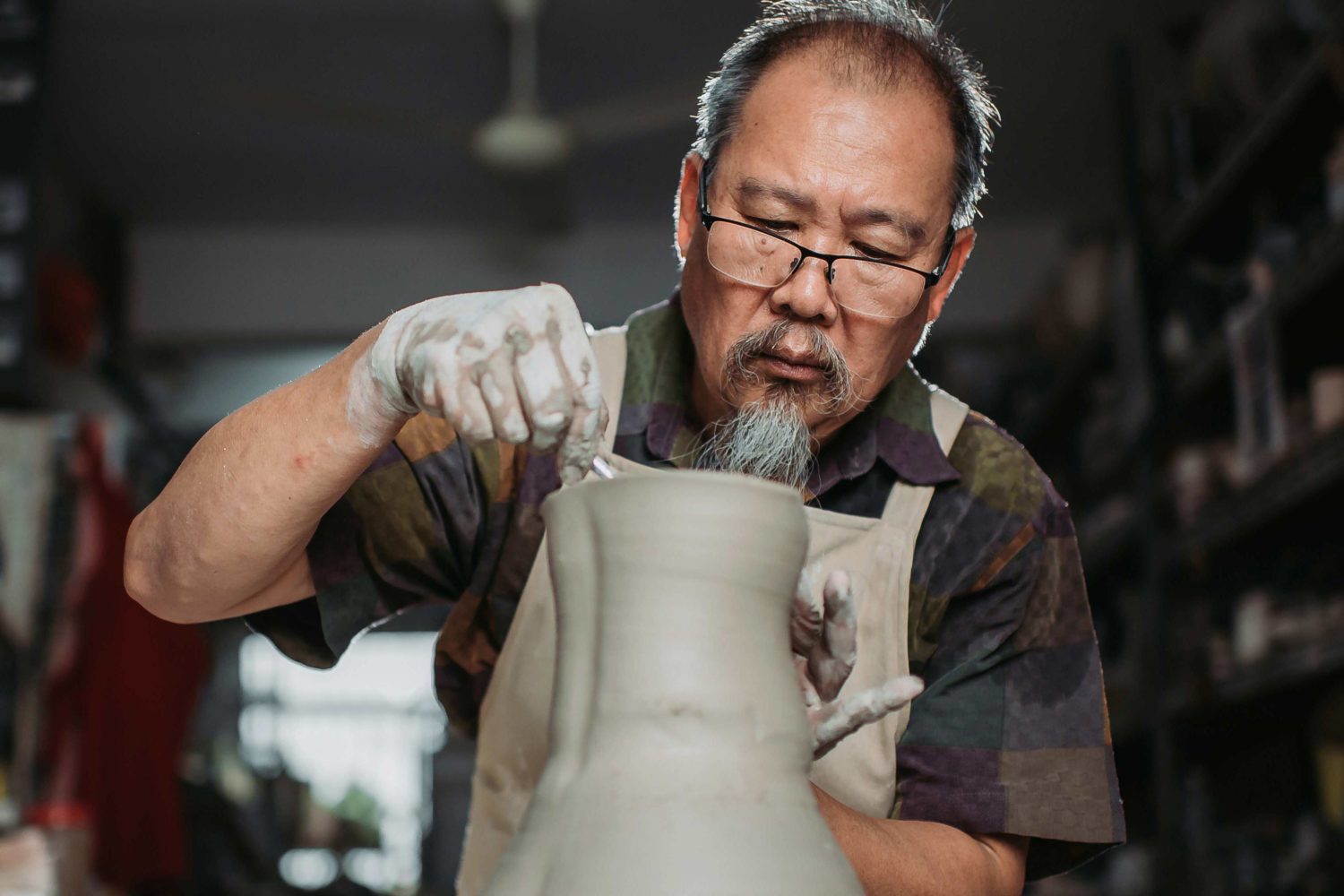It’s a quintessential Washington question, asked at happy hours and in the hallways of Capitol Hill, reflecting an ambitious, highly educated, status-attuned, purpose-driven city that lives to work as much as it works to live.
So, what do you do?
Of course, there are as many unique answers as there are jobs in our area. But some of those gigs stand out. They’re more intriguing. More memorable. Maybe even more fun. They pop–Wait, you do what?–because they’re simply, in a word, cool. They’re the kind of occupations your high-school guidance counselor never mentioned, that you instantly want to learn everything about, that make you wonder if it’s not too late to hand in your company laptop and completely change careers.
Take Lindley Johnson. He heads NASA’s Planetary Defense Coordination Office, which sounds boring and bureaucratic until you consider what he’s actually in charge of: scanning the skies for very big, very dangerous rocks headed toward Earth and figuring out ways to redirect or blow them to smithereens. (If that all sounds vaguely familiar, it was featured in the 2021 film Don’t Look Up; meanwhile, Johnson himself consulted on the 1990s comet-disaster flick Deep Impact.) Upon hearing what he does, Johnson says, some people are “incredulous that we need to have anybody worrying about that. But those that know a little bit more–or at least have seen the movies–have a little bit more positive reaction.”
When we went looking for some of Washington’s coolest jobs, we didn’t expect all of them to involve literally saving the world. But we did want each to produce, well, a positive reaction. Here’s what we found.
The Pop-Up Architect
Adriana Salame Aspiazu
She’s decking the halls at local bars—and not just for Christmas
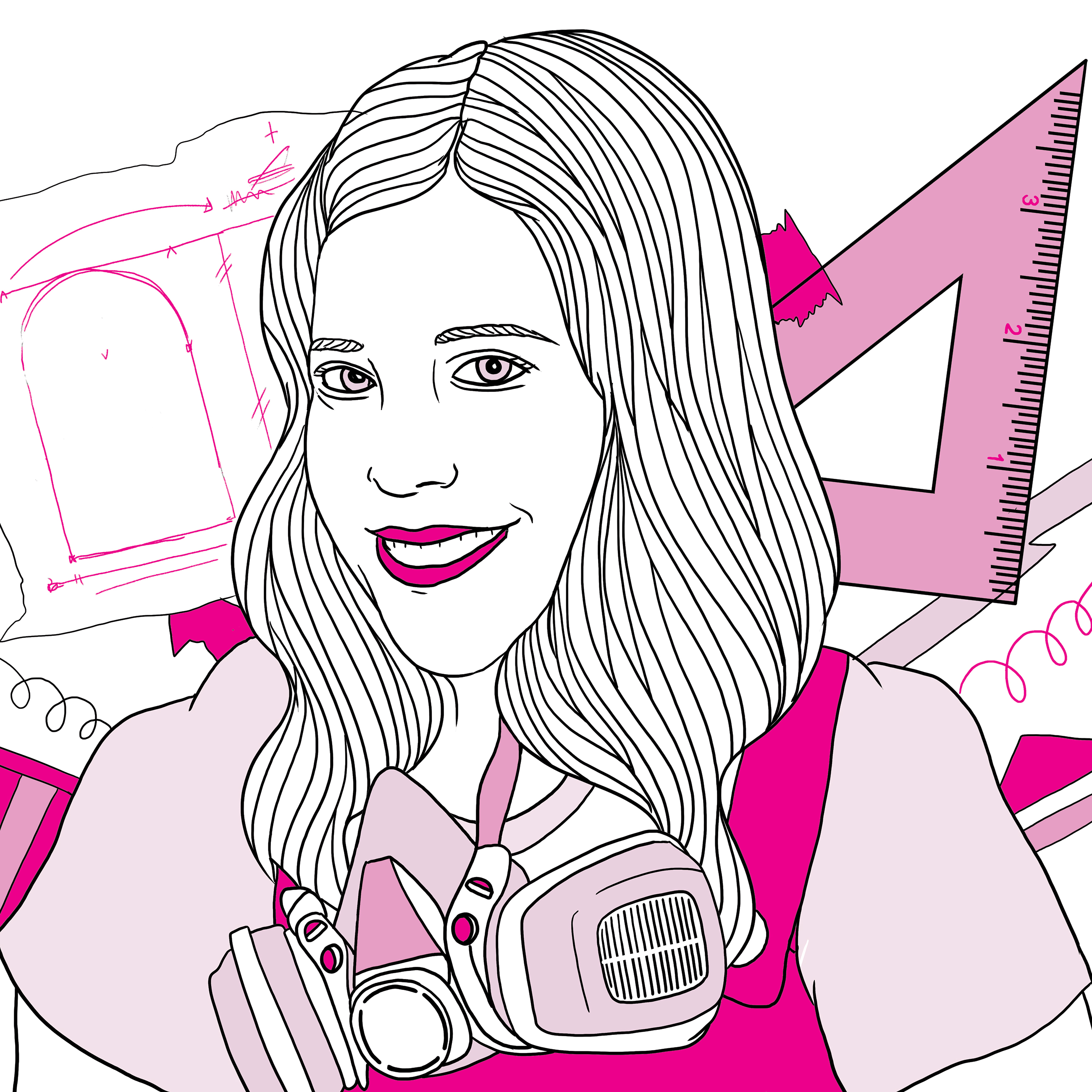
If you’ve ever spent hours waiting in line for a themed pop-up bar, there’s a good chance that Adriana Salame Aspiazu was responsible. The installation artist is one of the minds behind Miracle on 7th Street and the Cherry Blossom Pop-Up Bar, lauded for launching DC’s themed-bar craze. Now she operates independently, creating immersive, large-scale decor for bars as well as local institutions such as the National Portrait Gallery and the Wizards. Her work is a collaboration between right and left brain: There’s artistry in carving a replica of St. George’s Chapel for a royal-wedding theme, and behind each detail is copious research to capture a specific subculture. For a twisted-fairy-tale bar, Salame Aspiazu visited the Library of Congress, poring over old Brothers Grimm books. “When you walk into an art installation, there’s a piece of wanderlust that you can see in their faces,” she says. “The goal is to bring connection to people, influence them with art, and have them appreciate art.”
The Cartoon Pundit
Matt Wuerker
Drawing the state of the Union, one panel at a time

Coming of age during the Nixon administration, Matt Wuerker admired how political cartoonists put the disgraced President–with his long nose, jowly face, and bushy eye-brows–through the ringer. Some-day, he hoped to work in an era “as fascinating and topsyturvy.” He got his wish. An editorial cartoonist at Politico since 2006, Wuerker has thrived through political upheaval and surreality, his drawing board and watercolors planted resolutely in the corner of a busy newsroom. Wuerker uses few words, and his caricatures often emphasize a signature feature, such as George W. Bush’s and Barack Obama’s oversize ears or Donald Trump’s hair. The 2012 Pulitzer Prize winner appreciates when his images hit a nerve–provoking Twitter firestorms–and has mixed feelings about subjects such as Nancy Pelosi, Donald Rumsfeld, and Charlie Rangel (portrayed as a toad) calling to request his original caricatures of them. Above all, he enjoys the freedom his canvas provides. “I have very little adult supervision here,” he says. “They keep me on a very loose leash.”
The Professional Gamer
Justin Howell
A hoop dreamer mixing work and play on the digital hardwood
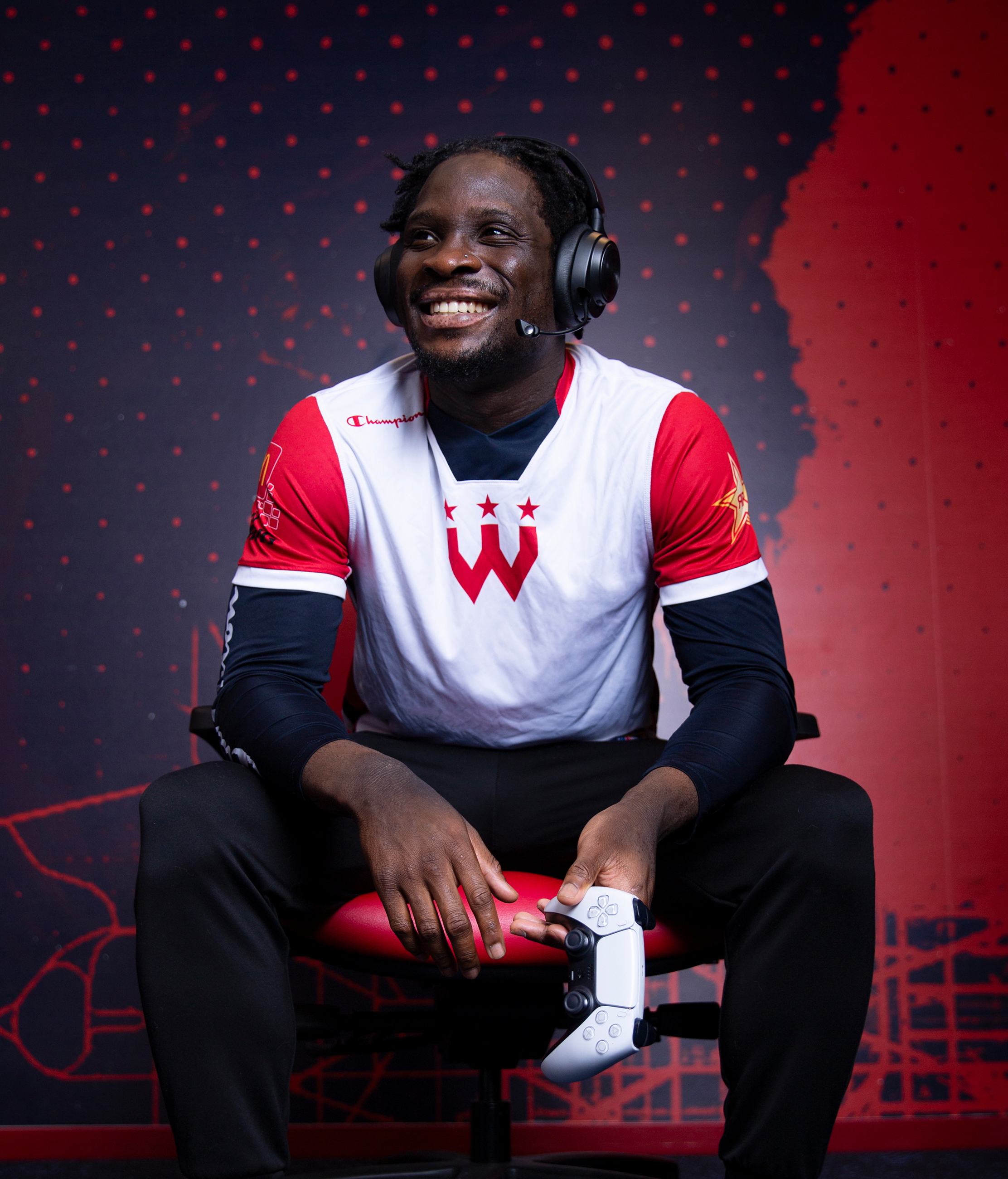
Justin Howell grew up playing “unhealthy hours” of the video game NBA 2K. So when he graduated from his New Jersey high school in 2018, he begged his mother to let him put off college so he could stay home, work at Best Buy, and try to make it as a pro gamer. “Just give me one year,” he told her. Today, thanks to his mom’s support and his own hard work, Howell is living his dream. After getting drafted by Ted Leonsis’s e-sports franchise, Wizards District Gaming–and yes, there are gaming drafts!–Howell now spends much of the year residing in a DC apartment complex with his gamer teammates, who compete against other NBA-affiliated e-sports squads in 2K. “The best part for me is being able to do what I love for a living,” says Howell, whose playing nickname is Just Awkward. “Even if I had chosen a different career path, I would still play NBA 2K because I love the game and the competition.”
The Ultimate Host
Nitiya Sin
For her guests, no detail is too small—or personal

The hospitality director for the restaurant group behind Michelin-starred Jônt and Bresca, Nitiya Sin likens herself to a golden retriever. A diner needs extra love or attention? Her job is to make them feel special. For a foodie who confessed to enjoying a slice of pizza after a fancy tasting menu, Sin arranged some “Papa Jônt’s,” a play on Papa John’s, showered in white truffles. For regulars with pups, she has made literal “doggy bags” with hand-stitched felt duck toys and gourmet treats. For a newly engaged couple, Sin discovered that the guy had proposed at 14th and Q streets while walking their beagle–so she constructed custom cake toppers of the street signs and their dog for a surprise dessert. Sin previously worked at Per Se and Minibar, but perhaps the best preparation for her current gig–which will see her decamp to South Florida for chef Ryan Ratino’s newest restaurant–was the many trips to Disneyland she took while growing up: “Feeling the joy and happiness and imagination from that really built my personality in a lot of ways.”
The Orchid Whisperer
George Guenthner
Tending to his garden, and ours
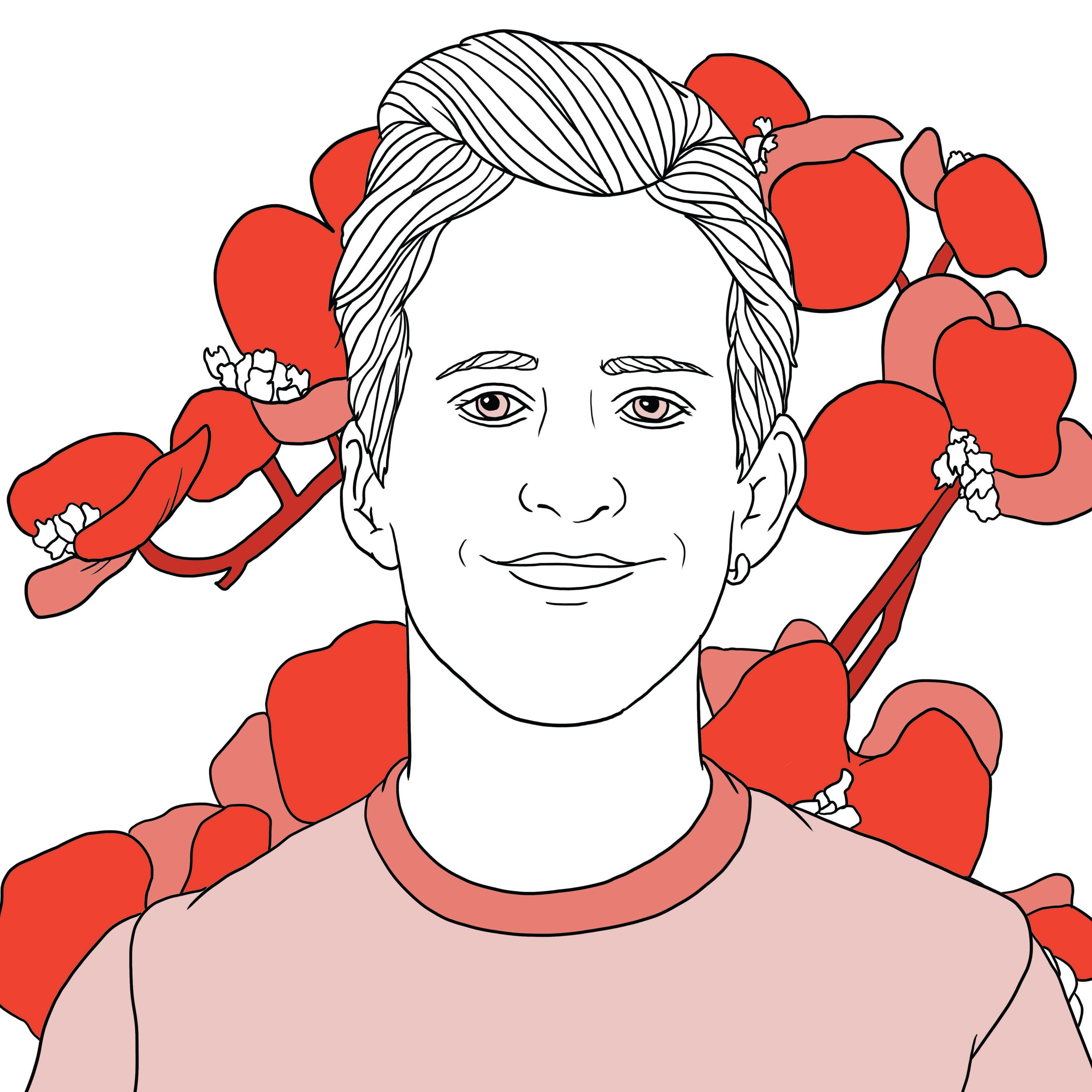
There’s a good chance you’ve been inside Guenthner’s office on the National Mall. In fact, you probably lingered there in awe, absorbing its lush greens and vibrant pinks. That’s because he oversees the orchid room at the U.S. Botanic Garden’s Conservatory, where he’s a gardener in charge of the collection. Guenthner starts his workdays pruning, watering, and curating the showy flora. About once a week, he slightly redesigns the ever-changing display–and has fun with fragrances, too, introducing flowers that smell sweetly of marzipan, cinnamon, even Froot Loops. In the afternoons, Guenthner moves to the Botanic Garden’s 85,000-square-foot production facility in Southwest DC, where he tends to a sea of more than 3,000 orchids, many rare and exotic. “Orchids, to me, are sort of manifestations of another world–a different, tropical place full of wonders and diversity,” he says. “They occupy a different sphere than our day-to-day lives here in DC.”
The Spirits Summoner
Chantal Tseng
Inspired by literature, her creative cocktails tell a story

Since 2015, veteran bartender Chantal Tseng has been transforming books into drinks with her Literary Cocktails series–which began in the library room of the Upshur Street bar Petworth Citizen, moved to the pioneering 14th Street speakeasy the Gibson, and now takes place at Baan Siam. Despite the changing locations, the basics of Tseng’s vision have remained constant: Use the descriptions, details, and background from fictional works to fashion one-of-a-kind (and delicious) cocktails. A passage about the promise of gold in Terry Pratchett’s Going Postal became a bourbon Gold Rush with Goldschläger schnapps, candied ginger, and honey syrup. The woodsy setting of Happiness Falls by Angie Kim yielded a botanical gin drink with piney génépy, yuzu, rosemary, and gochujang–a reference to the Korean background of Kim and some of her characters. “You’re conveying ideas through stories and metaphors,” Tseng says. “Drinks are also made up of stories.”
The Fashion Lawyer
Anthony Lupo
The fashion world and tech industry’s man in Washington

A lot of people have found out the hard way that Albert Einstein’s name is protected intellectual property. Anthony Lupo, chairman of the law firm ArentFox Schiff, is happy to explain over a decaf espresso–he pounds a dozen a day–in his downtown office. The room is filled with mementos from clients including Tesla, Apple, Pixar, and Hebrew University of Jerusalem, which owns Einstein’s IP. Lupo’s work regularly takes him to New York, Europe, and Silicon Valley and also allows him to act as what he calls a “consigliere” to the fashion world, which has similar IP-law needs. Some current concerns: AI, advertising and regulatory issues, and a fashion bigwig’s daughter getting caught sneaking into a bar. Lupo is an investor in Centrolina, where his signature dish of meat-balls is not on the menu–“You can’t call them Lupo’s Balls, you gotta call ’em Meatballs Alla Lupo,” he recalls telling owner/chef Amy Brandwein–and, in a rarity for someone with a prominent DC gig, he’s known for being a very good dresser. “No one has a cooler job,” Lupo says. “Not even Biden.”
The Folklife Globetrotter
Cristina Diaz-Carrera
She finds the world’s artists—and invites them back to Washington
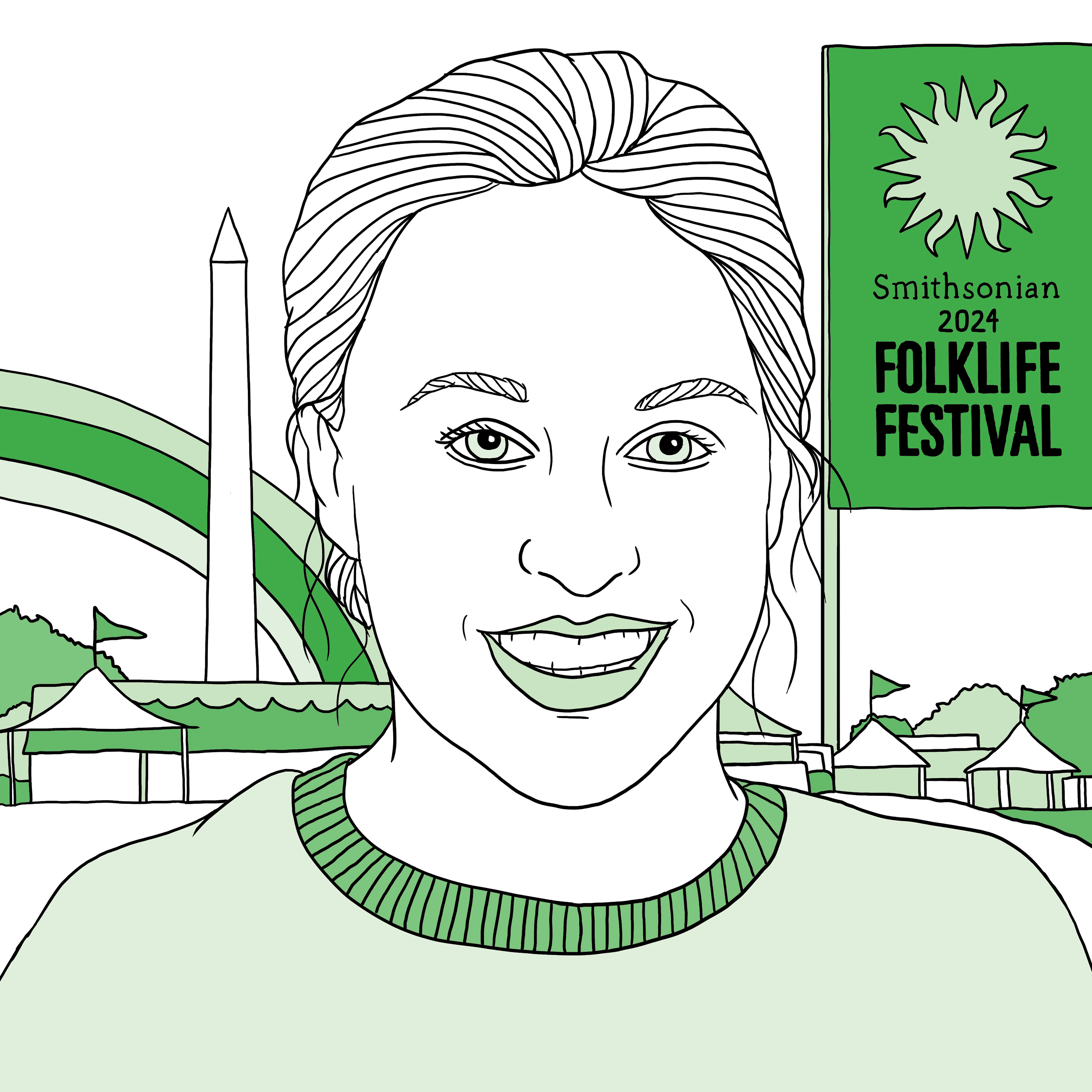
A DC institution for more than 50 years, the Smithsonian Folklife Festival can be transportive. For two mid-summer weeks, the National Mall is taken over by folk musicians, traditional dancers, seasoned wood workers and weavers, and expert cooks from across the globe. But Balinese dancers and veteran pie bakers from the Ozarks don’t just show up sight unseen. As curator at the Center for Folklife and Cultural Heritage, Cristina Diaz-Carrera tracks down potential festival participants everywhere traditional culture is alive and well–often in remote regions. An ethnomusicologist by training, she has located an expert luthier in coastal Mexico and boated into a marshy Colombian floodplain to witness centuries-old Holy Week festivities. Soon, Diaz-Carrera will head to northeastern Brazil–she hopes with her kids in tow for the first time–to continue research for a long-shelved program. “I get to travel in a way that I would never be able to travel as an individual,” she says.
The Crowd Pleaser
Talon
DC United’s mascot gets into costume–and into character
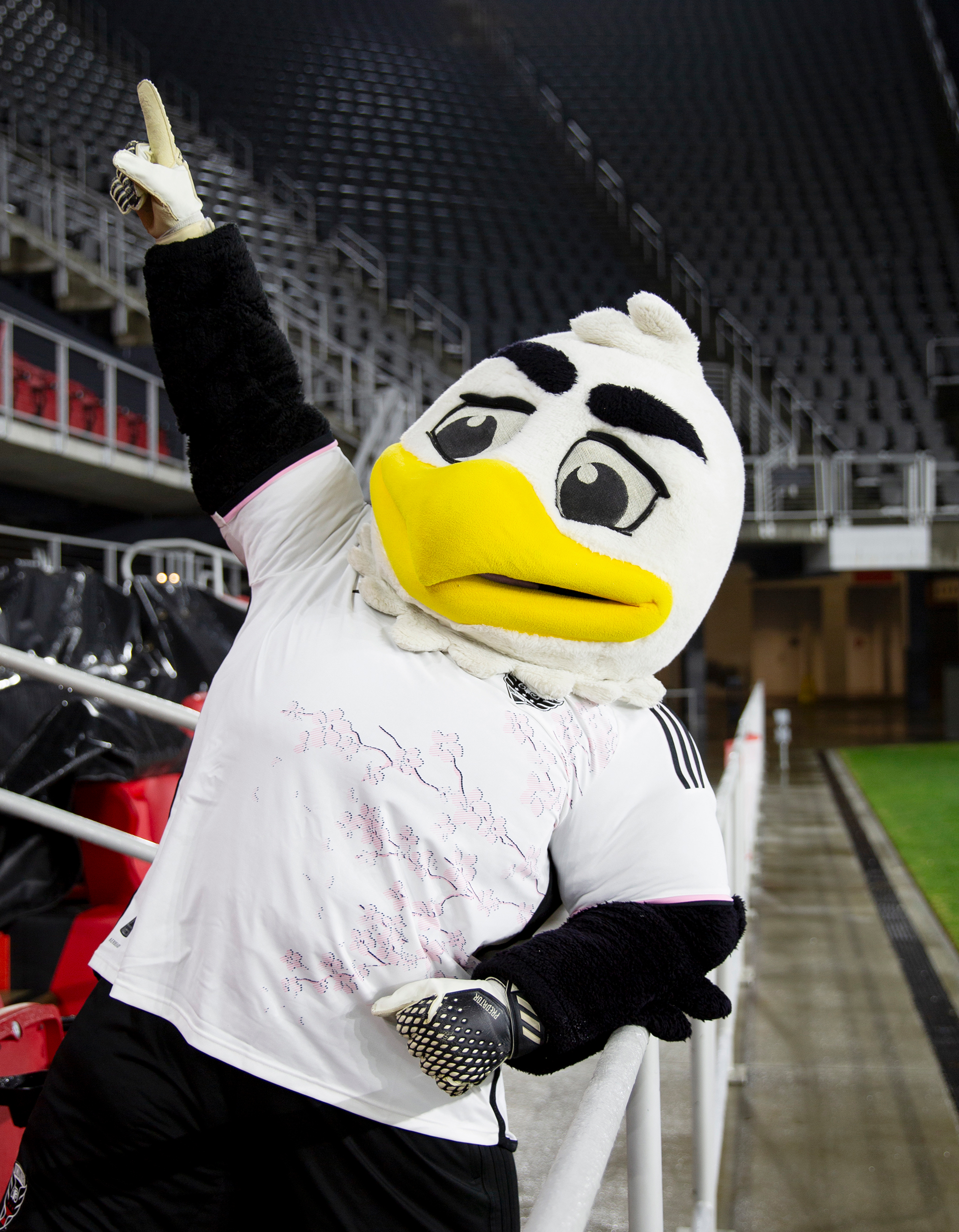
The man who entertains fans of the local Major League Soccer franchise prefers not to identify himself. Going nameless, he explains, ensures that the crowd’s attention remains fixed on the furry bald eagle bounding through the stands–and not the forty something professional theater-set builder inside the hot, stuffy costume. “The idea is that Talon is the character–so whether I’m in Talon or you are in Talon or an intern is in Talon, it’s still Talon,” he says. “If you lose the anonymity, then it becomes about you.” A former Washington Capitals T-shirt shooter, he stepped into the role in the early 2000s, when a friend–who happened to serve as Caps mascot Slapshot–learned that United needed a last-minute fill-in. Since then, he has come to relish waving at fans along the concourse, snapping pictures with kids, and seeing the joy on everyone’s face. “It’s really hard to have a bad day when everybody wants a hug or to high-five you,” he says.
The Armageddon Stopper
Lindley Johnson
Deep impact? Not on his watch.
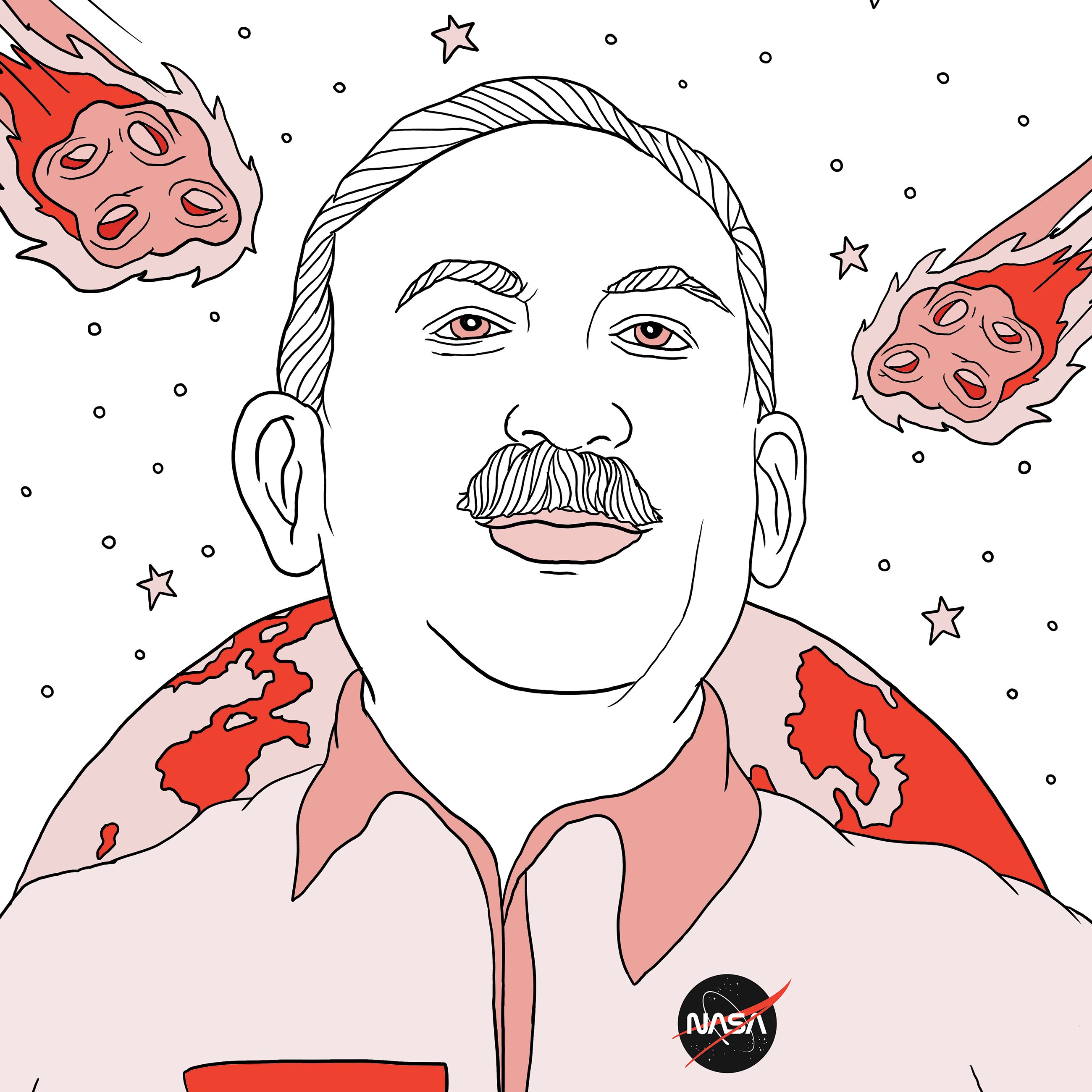
Approximately 66 million years ago, life on Earth had a bad day. An asteroid landed just off the coast of Mexico’s Yucatán Peninsula, triggering, scientists believe, a mass extinction that wiped out the dinosaurs. As NASA’s first-ever planetary-defense officer, Johnson is tasked with preventing a repeat. A college astronomy major, he served in the Air Force for 23 years and now coordinates efforts to detect and possibly redirect hazardous space rocks, otherwise known as near-Earth objects. None of the roughly 34,000 currently known NEOs poses a significant threat over the next century. However, NASA believes it has found only about 43 percent of the potentially dangerous NEOs out there. New telescopes coming online before 2030 should help spot the rest, and recently NASA changed the path of an asteroid by hitting it with a spacecraft–which could come in handy in the event of another planet-killer. “If there were an asteroid ever to impact the Earth, I’d be the first to know,” Johnson says. “I think that’s cool. Other people might not.”
The Jazz Detective
Zev Feldman
Lost music? This dogged producer is on the case.
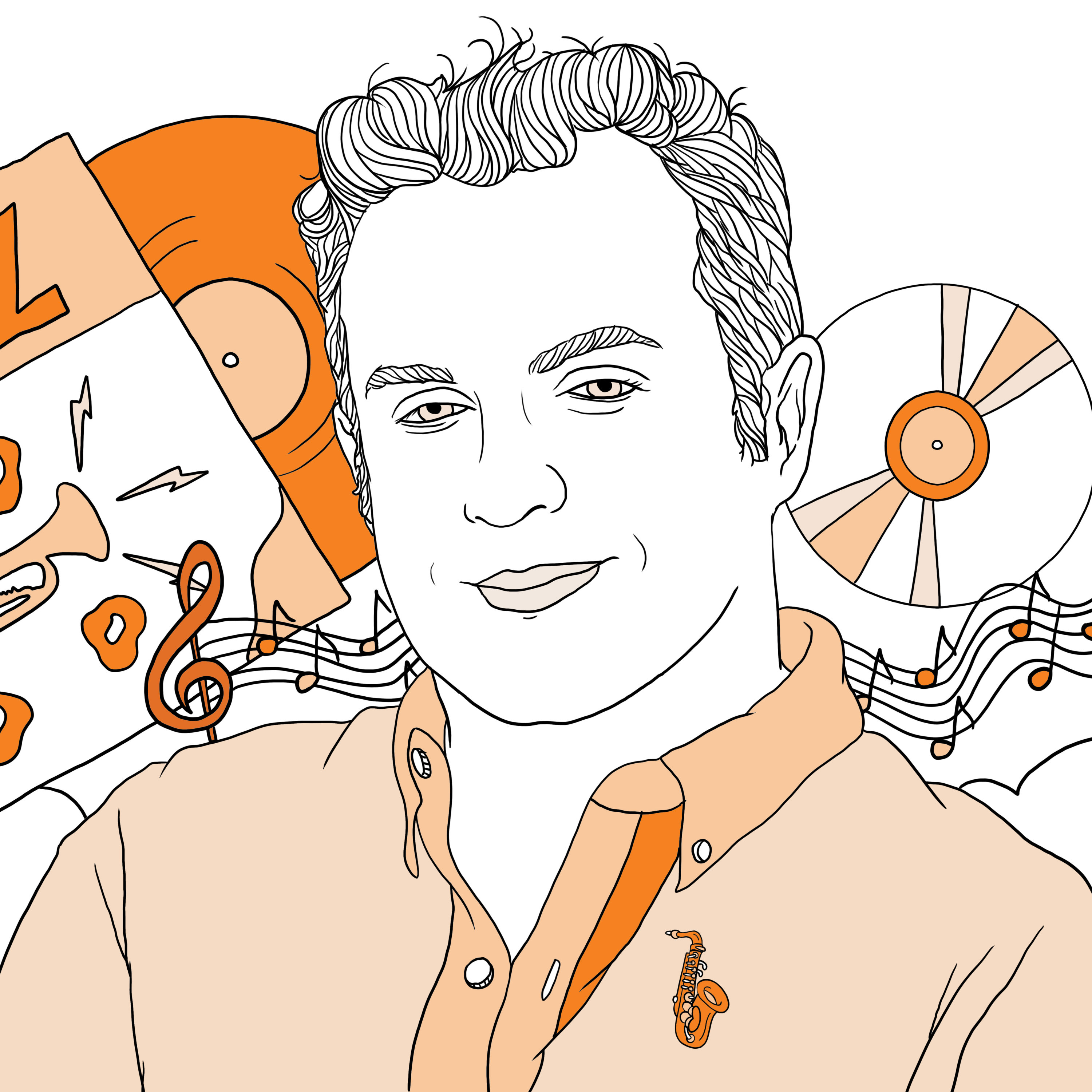
Montgomery Village has never been known as a jazz hotbed. But one of its townhouses contains a musical secret: an enthusiastic dude who’s one of the world’s top trackers of unheard recordings. For more than a decade, Zev Feldman has been uncovering lost sounds from the likes of Bill Evans, Albert Ayler, and Wes Montgomery; tracking down rights holders so people get paid; and producing the music for re-lease, usually in lavish packaging. A Grammy-nominated producer, Feldman is co-president of the renowned label Resonance Records and cofounder of another called Elemental Music; he also works with Blue Note and other imprints and has two labels of his own, Deep Digs and Jazz Detective. He does it all from his album-and-memorabilia-packed home, near where he grew up. “My neighbors and I are very friendly, but no one really knows what I’m doing,” says Feldman, who has ten new releases coming out in April. “I’m literally producing for five record labels. I just think it’s really freaking cool that I do that here.”
The Bookshelf Curator
Chuck Roberts
The man to call when your shelves need to make a statement
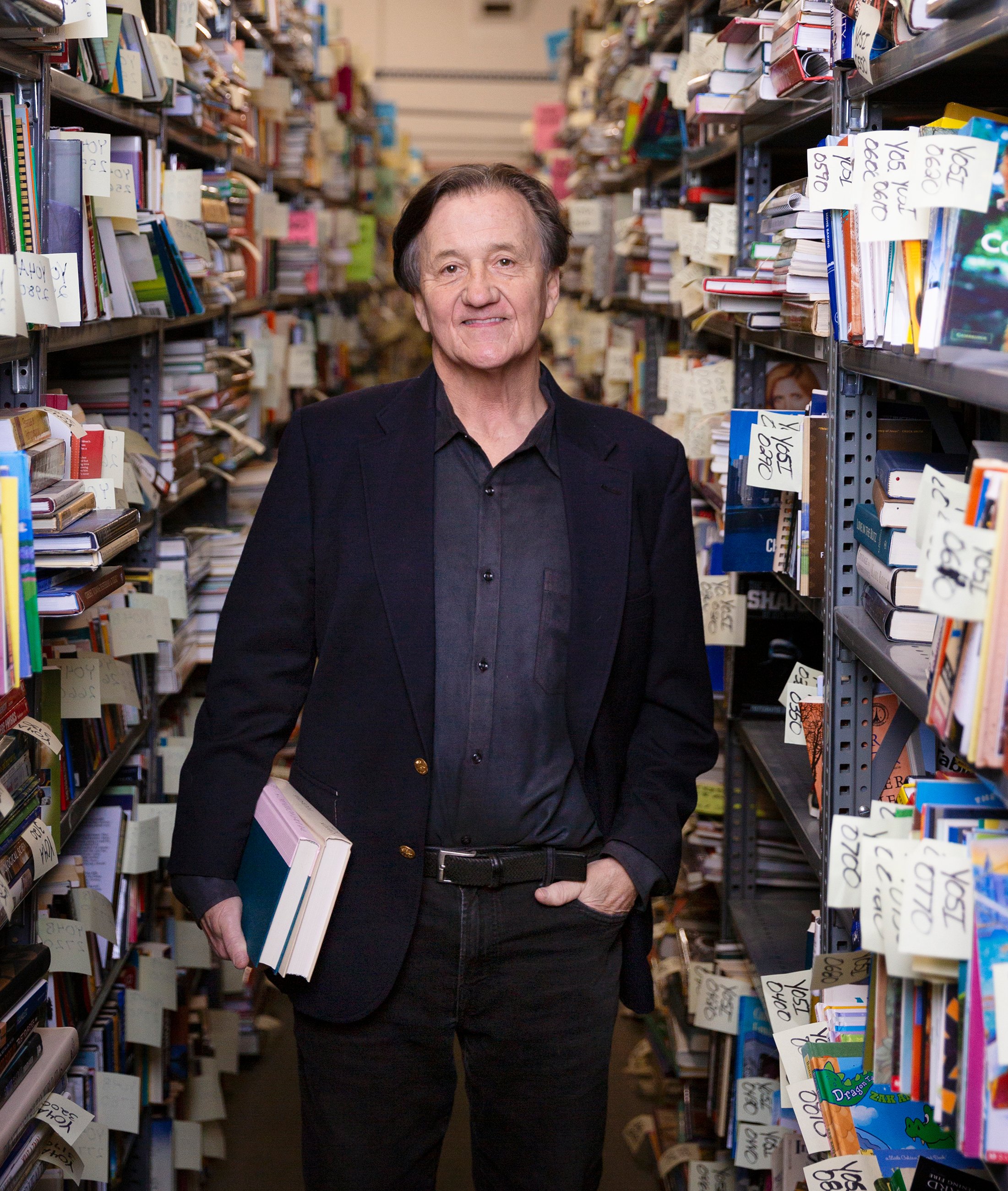
A service that curates book displays for things like Zoom backgrounds might sound like a pandemic-born enterprise, but Chuck Roberts has been helping people put their best bindings forward for decades. While he’s mostly a used-book seller–he has three Wonder Book stores in Maryland and roughly 5 million titles on hand–he also runs a service called Books by the Foot. He’ll source, say, an entire wall of robin’s-egg-blue books for an interior designer or a collection of cookbooks and murder mysteries for Hannibal Lecter’s lair in the TV series about the fictional serial killer. Then there are the video-chat mises-en-scène, which are similarly personalized. “People want books that reflect their taste,” Roberts says. “You don’t want anything embarrassing or silly, like Danielle Steel romances or something.”
The Body Woman
Mary Ellen O’Toole
Studying new ways to investigate homicides
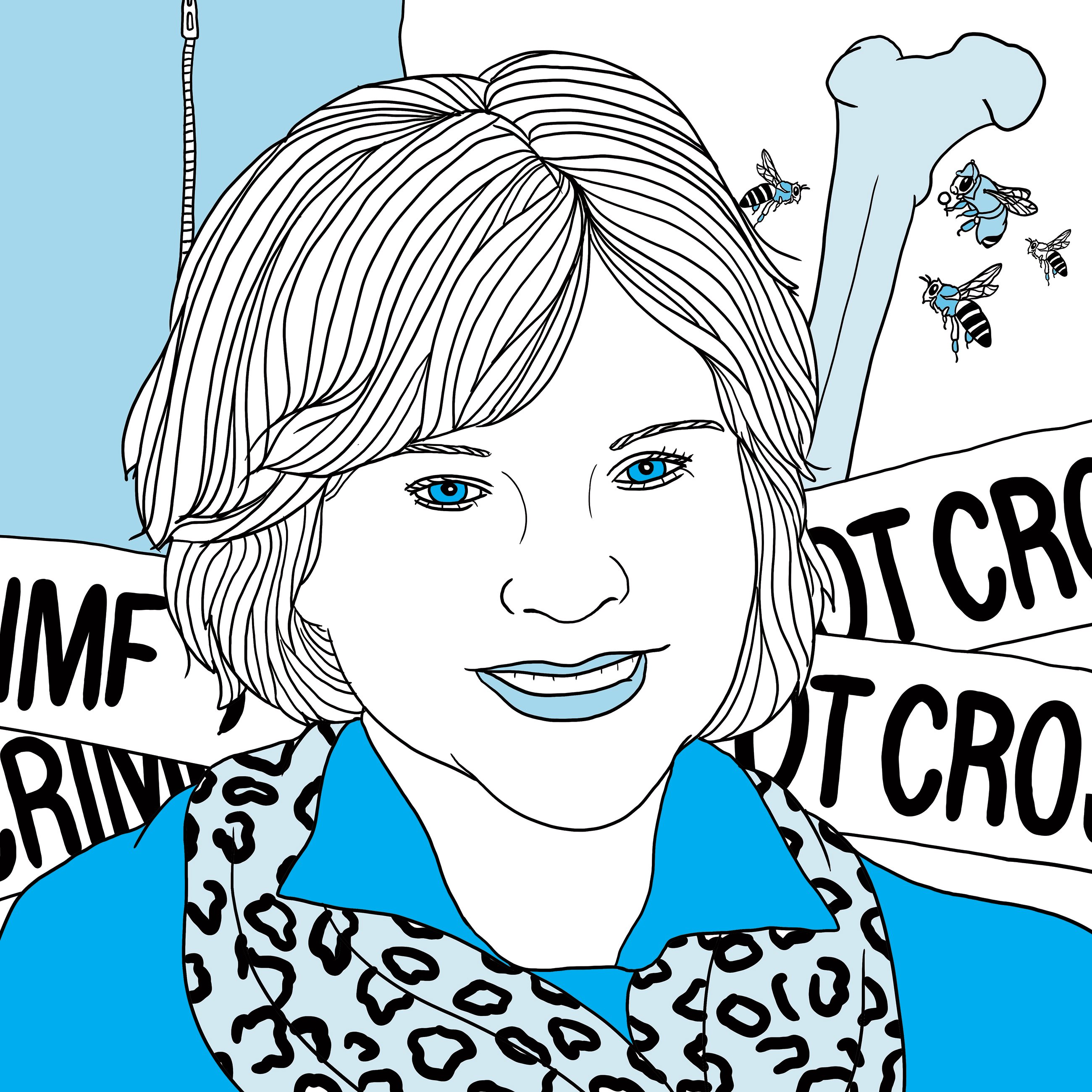
A murder. A body. Watch TV and you know what’s next: Detectives comb the scene, run some labs, and voilà!Case cracked. Except real life is more complicated. “We don’t really understand that much about human decomposition,” says Mary Ellen O’Toole. The director of George Mason’s forensic-science program, O’Toole heads the school’s “body farm,” one of a handful of facilities in the country that study cadavers the way they’re often found–hidden, in the middle of nowhere, left for weeks or years. On five wooded acres in Manassas, researchers and students are using drones, radar, and even honeybees that pick up chemicals created by decomposition to locate and glean more clues from human remains. “A lot of of-fenders think they are much smart-er than law enforcement,” says O’Toole, who previously profiled serial killers as an FBI agent. “Can they take every precaution not to make a mistake? Absolutely not. It’s just that the science hasn’t allowed us to catch up yet.”
The Master of Disaster
Donell Harvin
Worst-case scenarios are his specialty
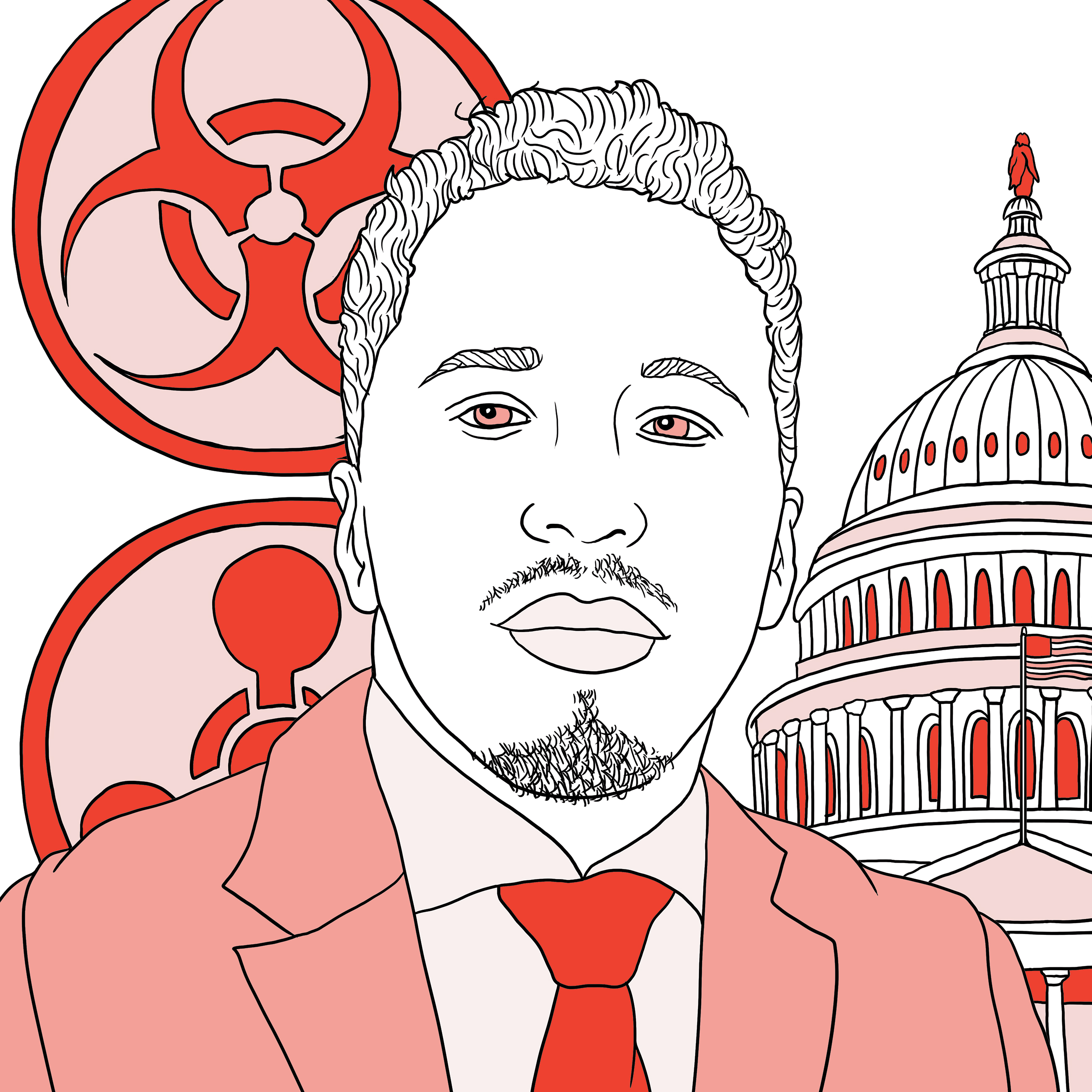
Donell Harvin has a tough time explaining what he does–“subjectmatter expert in homeland security” is the phrase he uses, which sounds pretty dry. Actually, his job is to have deep knowledge of some of the world’s most harrowing threats: biological weapons, domestic extremism, nuclear fallout. Harvin teaches at Georgetown and works with organizations including the United Nations and INTERPOL. In any given month, he might appear on MSNBC to discuss terrorism, fly to Ukraine to provide training on weapons of mass destruction, and work with Puerto Rico on natural-disaster response. Harvin started out as a New York City paramedic, but after responding to 9/11, he went to school to study terrorism. Next came several prominent roles in disaster management, putting him at the epicenter of some of this century’s most traumatic events: Sandy Hook, Hurricane Sandy, Covid, and January 6. Asked what keeps him up at night, Harvin jokes that it’s his dog snoring. “I don’t want to say I’ve seen it all,” he says, “but if I haven’t seen it at this point, I really don’t want to.”
The Dancing Queen
Ashley Murphy-Wilson
Producing onstage grace through behind-the-scenes grit

Ashley Murphy-Wilson has a scar on her chin, the result of jumping on–and falling off–her bed as a child. That led her mom to start her in ballet, along with gymnastics, swimming, tennis, piano, and singing lessons. “I had something to do every day after school,” she says. “Because I have a lot of energy.” Now dancing with the Washington Ballet, Murphy-Wilson brings the same vibrancy to the stage–and the same physicality to a gig that’s surprisingly similar to pro sports: late nights, long road trips, hours of unseen training, and lots of aches and injuries. “People think this isn’t a sport, because we make it look easy,” she says. “I don’t get to grunt and hit people, but my body’s going through the same things.” The payoff? Murphy-Wilson has performed at the Kennedy Center and the White House, in a Super Bowl ad, and as a visual clue on Jeopardy! “I think there’s a recording of that at my mom’s house,” she says. “And we still get residual checks from it, which is pretty cool.”
The Dog Marshal
Amy O’Connor
Commanding Walter Reed’s therapy-dog unit
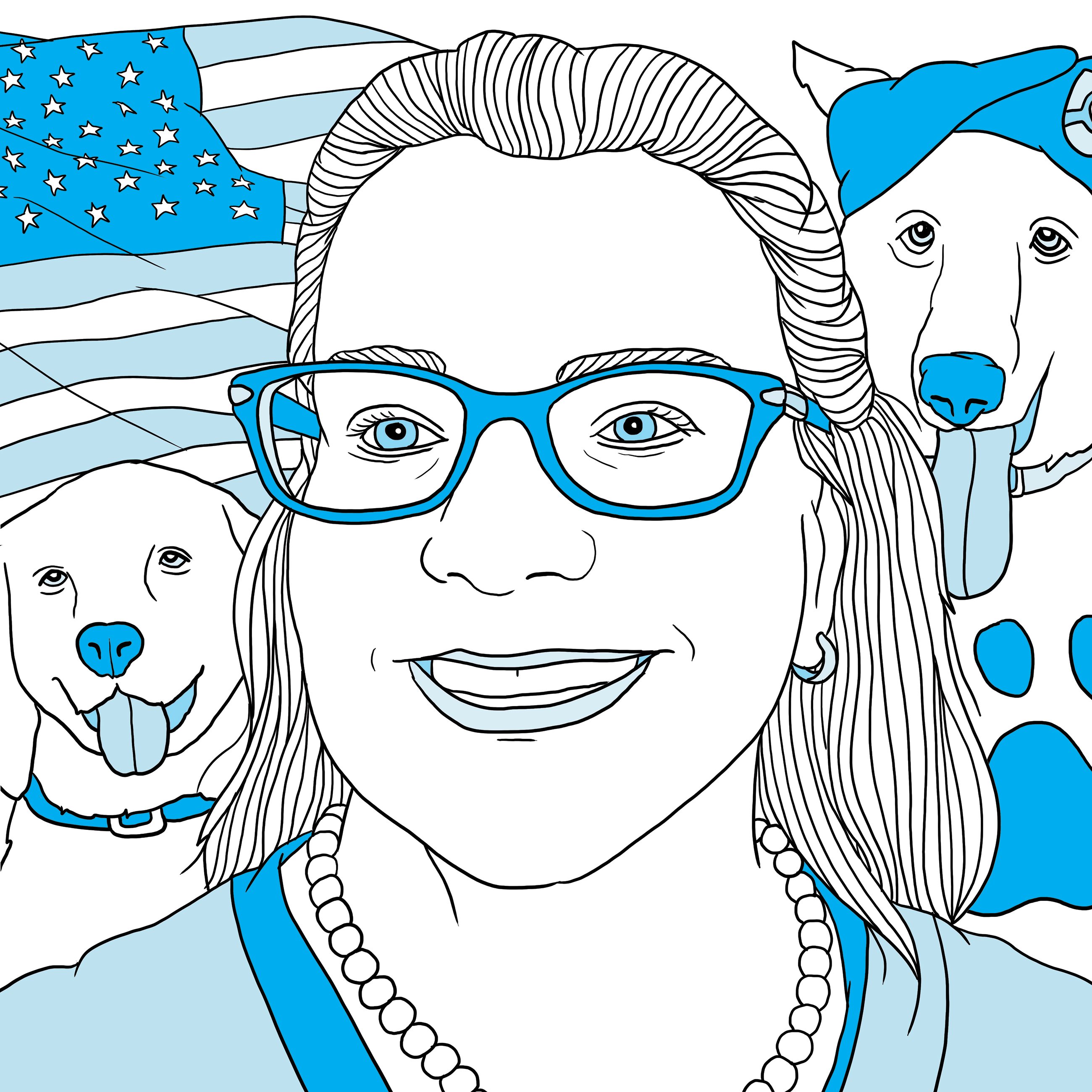
A few of Amy O’Connor’s most respected and decorated colleagues at Walter Reed National Military Medical Center are two-star major general Goldie, chief petty officer Sully, and Marine Corps corporal Biscuit. A social worker, she manages the hospital’s canine program, working with its eight therapy dogs and 12 human handlers to brighten the days of wounded servicemembers and other patients who may have few reasons to smile. O’Connor cofound-ed the program 17 years ago after getting the idea to bring a service dog to visit a family in the ICU. “I was like, ‘Wow, this is really powerful,’ ” she says. Bestowed with honorary ranks, the dogs are even-tempered, purpose-bred, and trained for their work–which includes helping people with brain injuries as they relearn motor tasks, playing with hospitalized veterans’ kids, curling up in bed with lonely patients, and helping staffers de-stress. “There is not a patient or staff member that asks for a visit that we do not do everything in our power to get to yes for,” O’Connor says. “We work to improve the human experience here.”
The Coolest Thing About My Job
Past and present Washingtonians of the Year tell us what makes their jobs cool
Mirah Horowitz
CEO and founder, Lucky Dog Animal Rescue

“Puppy kisses!
There’s just something special about an eight-week-old puppy, and I get to see so many without actually having to adopt them all myself.”
Bob Woodward
investigative reporter and author

“You get to ask the questions and the follow-ups.”
Shawn Yancy
NBC4 news anchor and founder, Giving Foundation for Women and Children
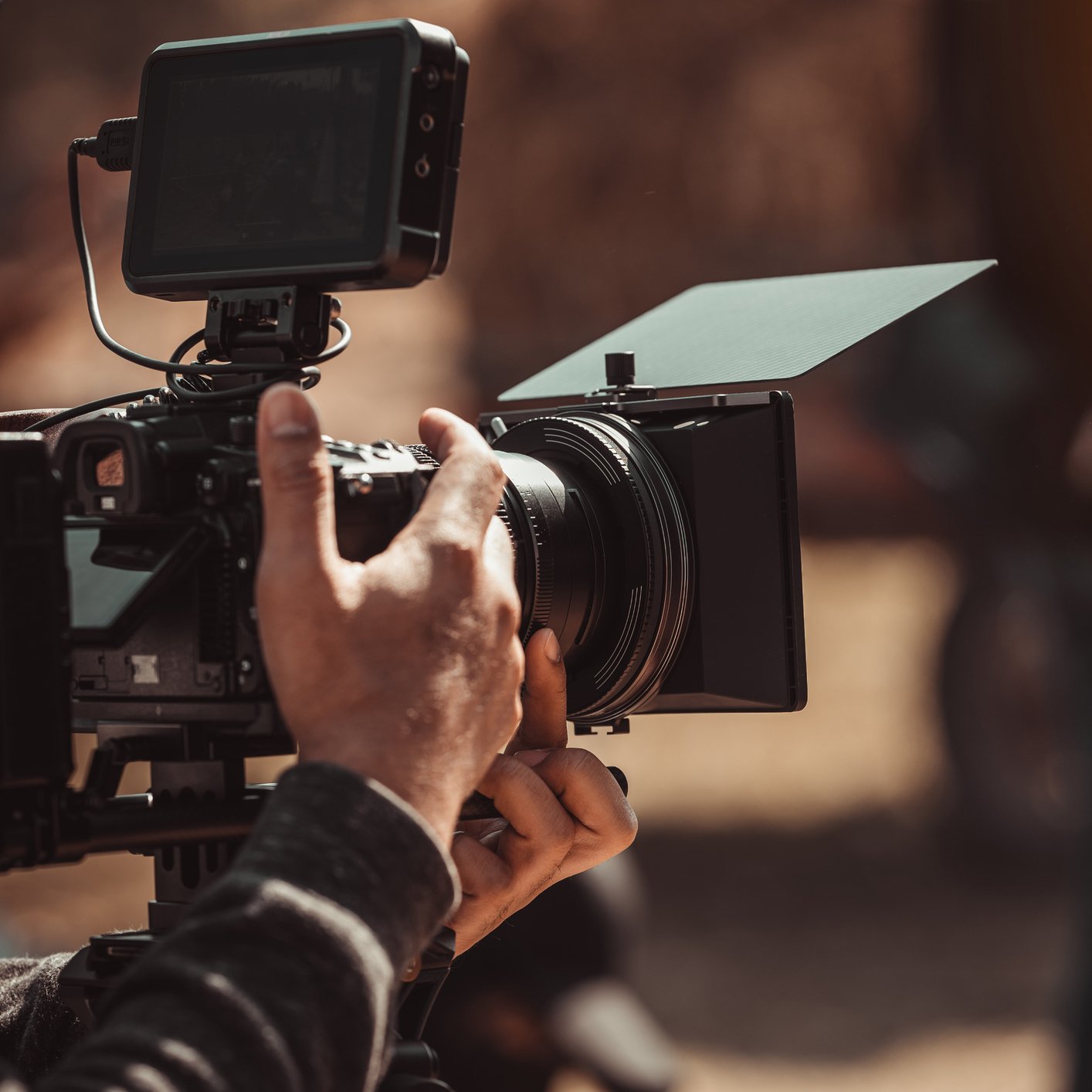
“Getting to meet so many incredible people, whether it’s the President of the United States or the lady at the grocery store who says, ‘I’m watching you every night.’ That’s the best.”
Carla Hayden
Librarian of Congress

“Nothing beats seeing someone’s jaw drop when they look at the draft of the Declaration of Independence or tear up when they read Rosa Parks’s letters or start humming when they look at Leonard Bernstein’s sheet music.”
Mike Locksley
University of Maryland head football coach

“Every year, I get a new batch of 18-to-22-year-olds in the locker room, and I have to keep adjusting to the times as they come in. So I’m kind of like Benjamin Button—I’m aging backwards.”
Back to Top
DC’s Least Cool Jobs
These familiar gigs may be necessary, but that doesn’t mean they’re beloved

Consultant
Look, we know you’re out there working hard to deploy systems, align strategies, integrate action plans, streamline processes to create new synergies, and otherwise deliver, uh, deliverables. Oh, and all those pretty PowerPoint decks? They’re certainly not writing themselves. Still, the existential question posed by the Bobs from the movie Office Space–themselves a pair of consultants!–applies: What would you say you do here?
Sidewalk clipboard holder
You took out student loans, immersed yourself in campus activism, earned a liberal-arts degree, and followed your heart to the most influential city on the planet, determined to make the world a better place by winning over hearts and minds . . . only to stand outside a Sweetgreen in a brightly colored T-shirt, hoping against hope that passersby will take your brochure and listen to your spiel–or, barring that, at least look up from their phones for a fleeting moment of eye contact. There’s participating in grassroots politics, and then there’s being a blade of grass shooting up from a crack in the concrete, only to get stepped on, over and over, by strangers in a hurry to be anywhere else.
Lobbyist
Quite possibly the only folks less respected than the politicians they seek to persuade, lobbyists manage a rare trifecta: despised for what they do (influence legislation), how they do it (out of sight, mostly), and what they represent (a society that often puts the needs of a powerful few over those of the powerless many). Of course, it’s also true that lobbying can help accomplish good things, that a government people can talk to is better than the alternative, and that in the end, they’re all special interests. So are lobbyists . . . actually cool? Maybe they need to make a better case for it.
Back to Top
The Washington “Cool Job” Matrix
A visual guide to how some of our city’s most coveted and familiar gigs compare with one another
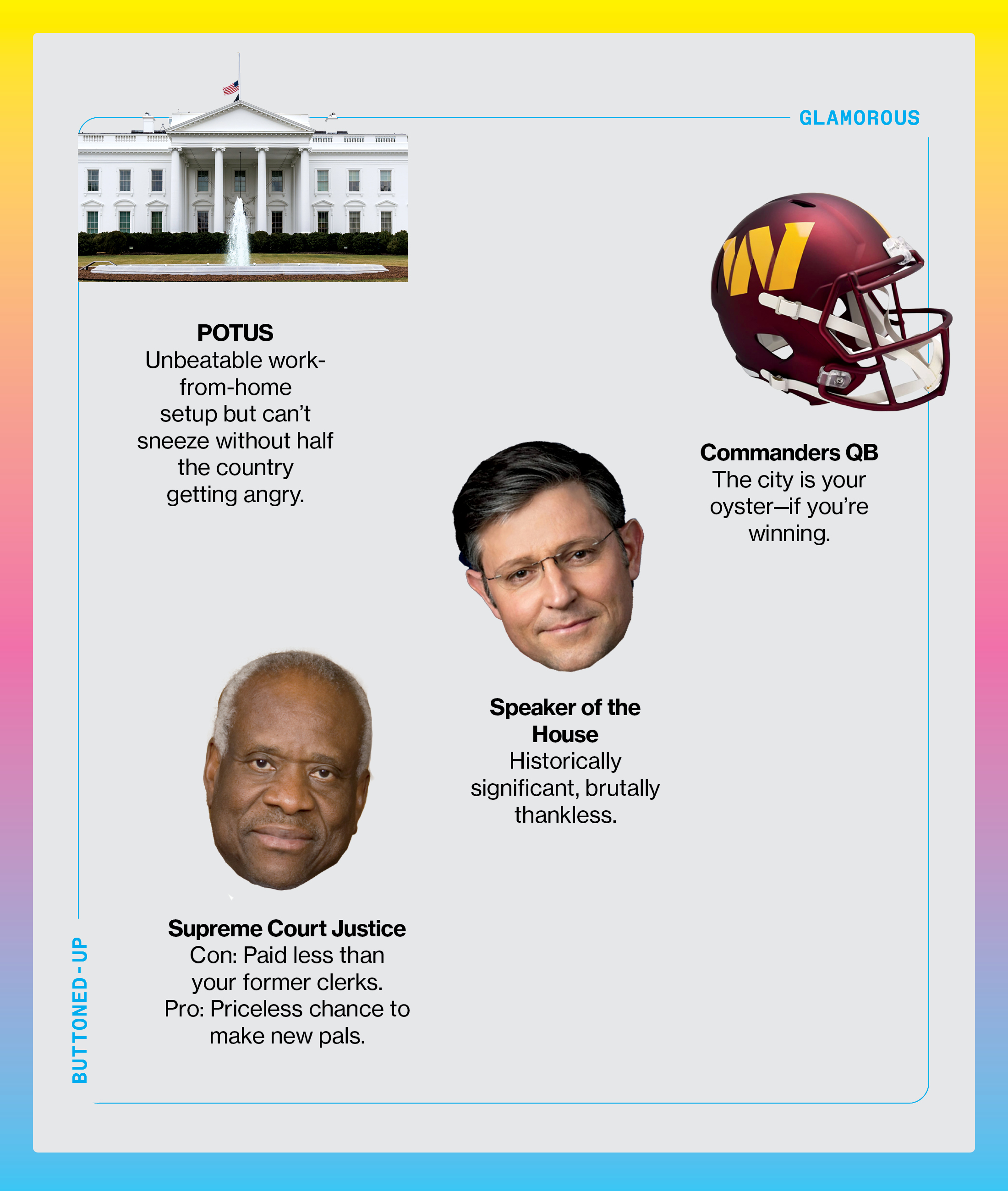

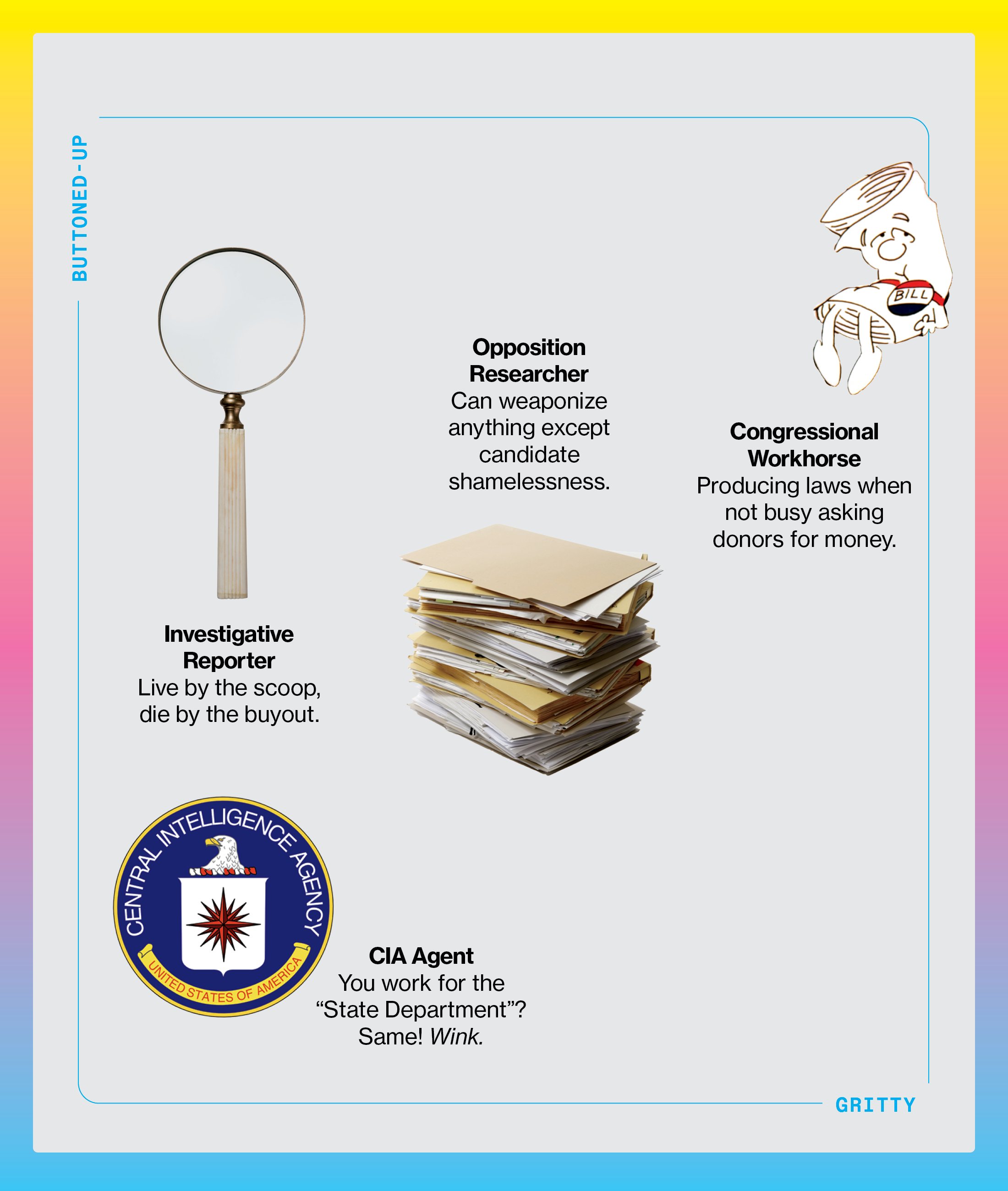
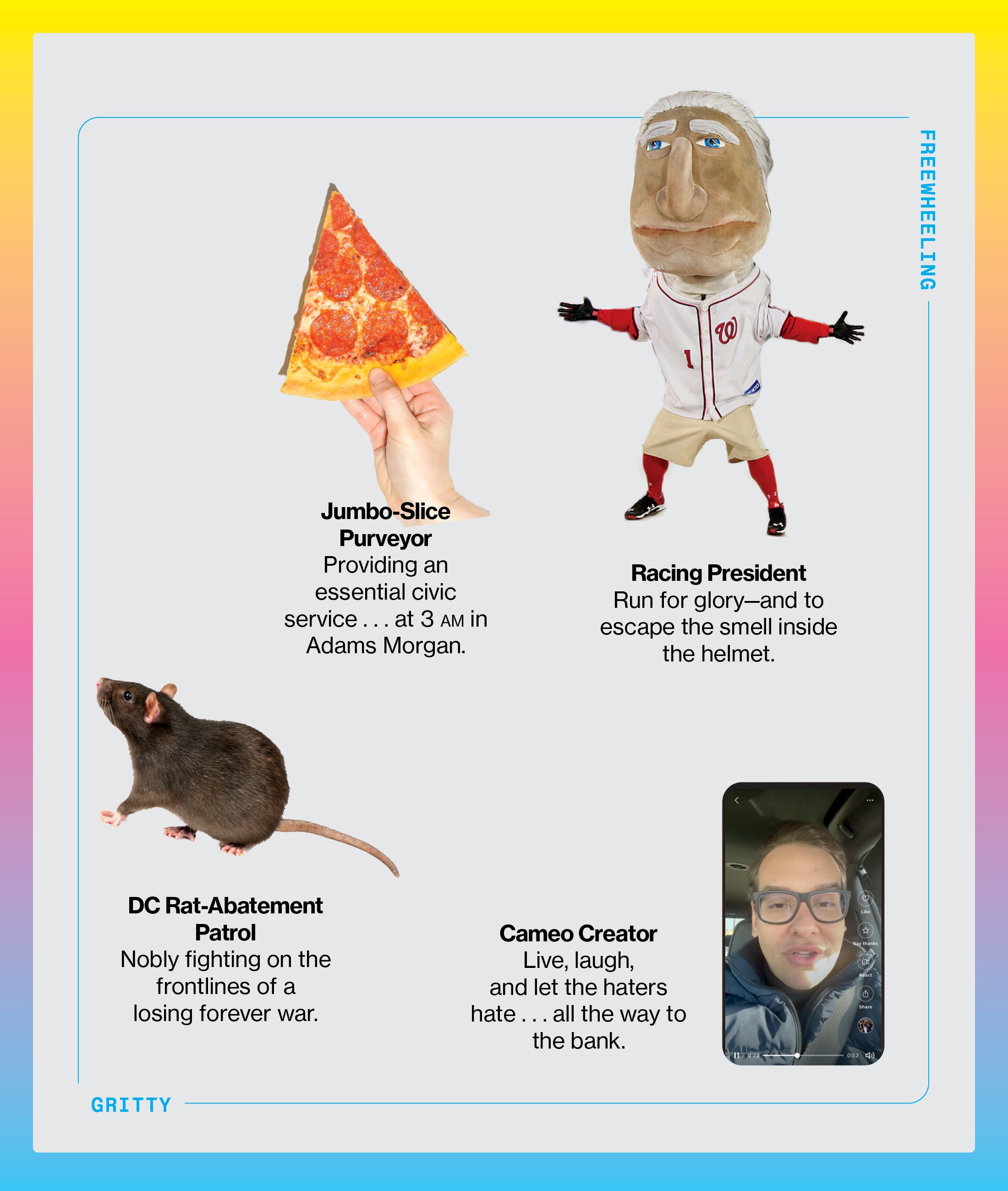
It’s a quintessential Washington question, asked at happy hours and in the hallways of Capitol Hill, reflecting an ambitious, highly educated, status-attuned, purpose-driven city that lives to work as much as it works to live.
So, what do you do?
Of course, there are as many unique answers as there are jobs in our area. But some of those gigs stand out. They’re more intriguing. More memorable. Maybe even more fun. They pop–Wait, you do what?–because they’re simply, in a word, cool. They’re the kind of occupations your high-school guidance counselor never mentioned, that you instantly want to learn everything about, that make you wonder if it’s not too late to hand in your company laptop and completely change careers.
Take Lindley Johnson. He heads NASA’s Planetary Defense Coordination Office, which sounds boring and bureaucratic until you consider what he’s actually in charge of: scanning the skies for very big, very dangerous rocks headed toward Earth and figuring out ways to redirect or blow them to smithereens. (If that all sounds vaguely familiar, it was featured in the 2021 film Don’t Look Up; meanwhile, Johnson himself consulted on the 1990s comet-disaster flick Deep Impact.) Upon hearing what he does, Johnson says, some people are “incredulous that we need to have anybody worrying about that. But those that know a little bit more–or at least have seen the movies–have a little bit more positive reaction.”
When we went looking for some of Washington’s coolest jobs, we didn’t expect all of them to involve literally saving the world. But we did want each to produce, well, a positive reaction. Here’s what we found.

The Pop-Up Architect
Adriana Salame Aspiazu
She’s decking the halls at local bars—and not just for Christmas
If you’ve ever spent hours waiting in line for a themed pop-up bar, there’s a good chance that Adriana Salame Aspiazu was responsible. The installation artist is one of the minds behind Miracle on 7th Street and the Cherry Blossom Pop-Up Bar, lauded for launching DC’s themed-bar craze. Now she operates independently, creating immersive, large-scale decor for bars as well as local institutions such as the National Portrait Gallery and the Wizards. Her work is a collaboration between right and left brain: There’s artistry in carving a replica of St. George’s Chapel for a royal-wedding theme, and behind each detail is copious research to capture a specific subculture. For a twisted-fairy-tale bar, Salame Aspiazu visited the Library of Congress, poring over old Brothers Grimm books. “When you walk into an art installation, there’s a piece of wanderlust that you can see in their faces,” she says. “The goal is to bring connection to people, influence them with art, and have them appreciate art.”
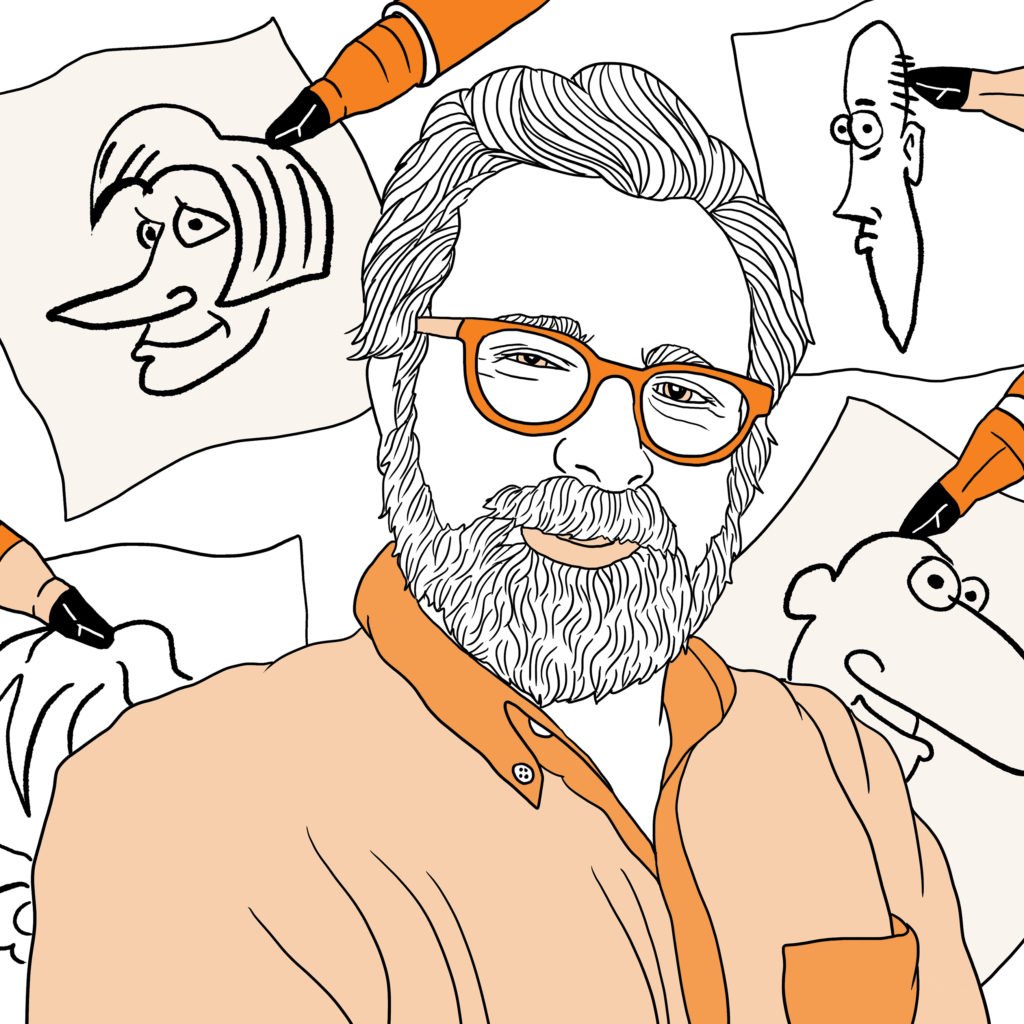
The Cartoon Pundit
Matt Wuerker
Drawing the state of the Union, one panel at a time
Coming of age during the Nixon administration, Matt Wuerker admired how political cartoonists put the disgraced President–with his long nose, jowly face, and bushy eye-brows–through the ringer. Some-day, he hoped to work in an era “as fascinating and topsyturvy.” He got his wish. An editorial cartoonist at Politico since 2006, Wuerker has thrived through political upheaval and surreality, his drawing board and watercolors planted resolutely in the corner of a busy newsroom. Wuerker uses few words, and his caricatures often emphasize a signature feature, such as George W. Bush’s and Barack Obama’s oversize ears or Donald Trump’s hair. The 2012 Pulitzer Prize winner appreciates when his images hit a nerve–provoking Twitter firestorms–and has mixed feelings about subjects such as Nancy Pelosi, Donald Rumsfeld, and Charlie Rangel (portrayed as a toad) calling to request his original caricatures of them. Above all, he enjoys the freedom his canvas provides. “I have very little adult supervision here,” he says. “They keep me on a very loose leash.”

The Professional Gamer
Justin Howell
A hoop dreamer mixing work and play on the digital hardwood
Justin Howell grew up playing “unhealthy hours” of the video game NBA 2K. So when he graduated from his New Jersey high school in 2018, he begged his mother to let him put off college so he could stay home, work at Best Buy, and try to make it as a pro gamer. “Just give me one year,” he told her. Today, thanks to his mom’s support and his own hard work, Howell is living his dream. After getting drafted by Ted Leonsis’s e-sports franchise, Wizards District Gaming–and yes, there are gaming drafts!–Howell now spends much of the year residing in a DC apartment complex with his gamer teammates, who compete against other NBA-affiliated e-sports squads in 2K. “The best part for me is being able to do what I love for a living,” says Howell, whose playing nickname is Just Awkward. “Even if I had chosen a different career path, I would still play NBA 2K because I love the game and the competition.”

The Ultimate Host
Nitiya Sin
For her guests, no detail is too small—or personal
The hospitality director for the restaurant group behind Michelin-starred Jônt and Bresca, Nitiya Sin likens herself to a golden retriever. A diner needs extra love or attention? Her job is to make them feel special. For a foodie who confessed to enjoying a slice of pizza after a fancy tasting menu, Sin arranged some “Papa Jônt’s,” a play on Papa John’s, showered in white truffles. For regulars with pups, she has made literal “doggy bags” with hand-stitched felt duck toys and gourmet treats. For a newly engaged couple, Sin discovered that the guy had proposed at 14th and Q streets while walking their beagle–so she constructed custom cake toppers of the street signs and their dog for a surprise dessert. Sin previously worked at Per Se and Minibar, but perhaps the best preparation for her current gig–which will see her decamp to South Florida for chef Ryan Ratino’s newest restaurant–was the many trips to Disneyland she took while growing up: “Feeling the joy and happiness and imagination from that really built my personality in a lot of ways.”

The Orchid Whisperer
George Guenthner
Tending to his garden, and ours
There’s a good chance you’ve been inside Guenthner’s office on the National Mall. In fact, you probably lingered there in awe, absorbing its lush greens and vibrant pinks. That’s because he oversees the orchid room at the U.S. Botanic Garden’s Conservatory, where he’s a gardener in charge of the collection. Guenthner starts his workdays pruning, watering, and curating the showy flora. About once a week, he slightly redesigns the ever-changing display–and has fun with fragrances, too, introducing flowers that smell sweetly of marzipan, cinnamon, even Froot Loops. In the afternoons, Guenthner moves to the Botanic Garden’s 85,000-square-foot production facility in Southwest DC, where he tends to a sea of more than 3,000 orchids, many rare and exotic. “Orchids, to me, are sort of manifestations of another world–a different, tropical place full of wonders and diversity,” he says. “They occupy a different sphere than our day-to-day lives here in DC.”

The Spirits Summoner
Chantal Tseng
Inspired by literature, her creative cocktails tell a story
Since 2015, veteran bartender Chantal Tseng has been transforming books into drinks with her Literary Cocktails series–which began in the library room of the Upshur Street bar Petworth Citizen, moved to the pioneering 14th Street speakeasy the Gibson, and now takes place at Baan Siam. Despite the changing locations, the basics of Tseng’s vision have remained constant: Use the descriptions, details, and background from fictional works to fashion one-of-a-kind (and delicious) cocktails. A passage about the promise of gold in Terry Pratchett’s Going Postal became a bourbon Gold Rush with Goldschläger schnapps, candied ginger, and honey syrup. The woodsy setting of Happiness Falls by Angie Kim yielded a botanical gin drink with piney génépy, yuzu, rosemary, and gochujang–a reference to the Korean background of Kim and some of her characters. “You’re conveying ideas through stories and metaphors,” Tseng says. “Drinks are also made up of stories.”
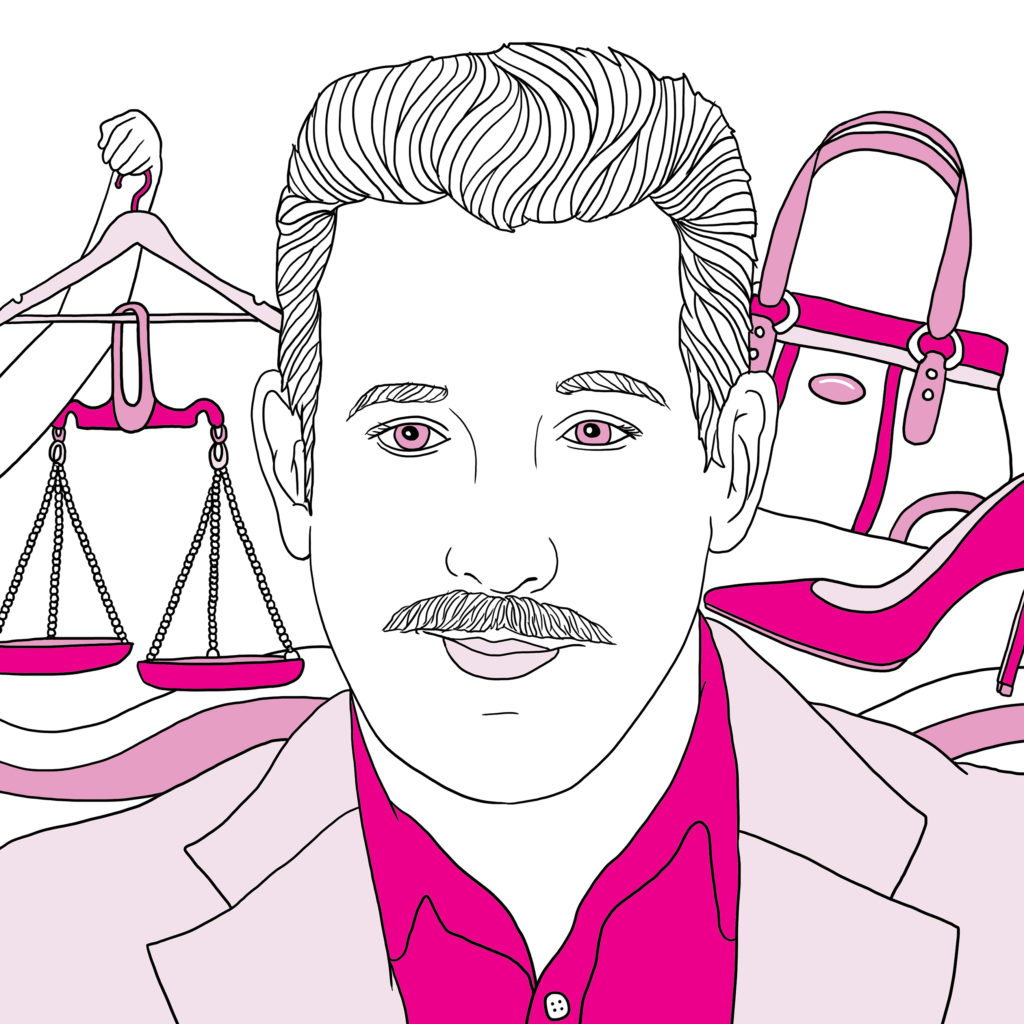
The Fashion Lawyer
Anthony Lupo
The fashion world and tech industry’s man in Washington
A lot of people have found out the hard way that Albert Einstein’s name is protected intellectual property. Anthony Lupo, chairman of the law firm ArentFox Schiff, is happy to explain over a decaf espresso–he pounds a dozen a day–in his downtown office. The room is filled with mementos from clients including Tesla, Apple, Pixar, and Hebrew University of Jerusalem, which owns Einstein’s IP. Lupo’s work regularly takes him to New York, Europe, and Silicon Valley and also allows him to act as what he calls a “consigliere” to the fashion world, which has similar IP-law needs. Some current concerns: AI, advertising and regulatory issues, and a fashion bigwig’s daughter getting caught sneaking into a bar. Lupo is an investor in Centrolina, where his signature dish of meat-balls is not on the menu–“You can’t call them Lupo’s Balls, you gotta call ’em Meatballs Alla Lupo,” he recalls telling owner/chef Amy Brandwein–and, in a rarity for someone with a prominent DC gig, he’s known for being a very good dresser. “No one has a cooler job,” Lupo says. “Not even Biden.”

The Folklife Globetrotter
Cristina Diaz-Carrera
She finds the world’s artists—and invites them back to Washington
A DC institution for more than 50 years, the Smithsonian Folklife Festival can be transportive. For two mid-summer weeks, the National Mall is taken over by folk musicians, traditional dancers, seasoned wood workers and weavers, and expert cooks from across the globe. But Balinese dancers and veteran pie bakers from the Ozarks don’t just show up sight unseen. As curator at the Center for Folklife and Cultural Heritage, Cristina Diaz-Carrera tracks down potential festival participants everywhere traditional culture is alive and well–often in remote regions. An ethnomusicologist by training, she has located an expert luthier in coastal Mexico and boated into a marshy Colombian floodplain to witness centuries-old Holy Week festivities. Soon, Diaz-Carrera will head to northeastern Brazil–she hopes with her kids in tow for the first time–to continue research for a long-shelved program. “I get to travel in a way that I would never be able to travel as an individual,” she says.

The Crowd Pleaser
Talon
DC United’s mascot gets into costume–and into character
The man who entertains fans of the local Major League Soccer franchise prefers not to identify himself. Going nameless, he explains, ensures that the crowd’s attention remains fixed on the furry bald eagle bounding through the stands–and not the forty something professional theater-set builder inside the hot, stuffy costume. “The idea is that Talon is the character–so whether I’m in Talon or you are in Talon or an intern is in Talon, it’s still Talon,” he says. “If you lose the anonymity, then it becomes about you.” A former Washington Capitals T-shirt shooter, he stepped into the role in the early 2000s, when a friend–who happened to serve as Caps mascot Slapshot–learned that United needed a last-minute fill-in. Since then, he has come to relish waving at fans along the concourse, snapping pictures with kids, and seeing the joy on everyone’s face. “It’s really hard to have a bad day when everybody wants a hug or to high-five you,” he says.

The Armageddon Stopper
Lindley Johnson
Deep impact? Not on his watch.
Approximately 66 million years ago, life on Earth had a bad day. An asteroid landed just off the coast of Mexico’s Yucatán Peninsula, triggering, scientists believe, a mass extinction that wiped out the dinosaurs. As NASA’s first-ever planetary-defense officer, Johnson is tasked with preventing a repeat. A college astronomy major, he served in the Air Force for 23 years and now coordinates efforts to detect and possibly redirect hazardous space rocks, otherwise known as near-Earth objects. None of the roughly 34,000 currently known NEOs poses a significant threat over the next century. However, NASA believes it has found only about 43 percent of the potentially dangerous NEOs out there. New telescopes coming online before 2030 should help spot the rest, and recently NASA changed the path of an asteroid by hitting it with a spacecraft–which could come in handy in the event of another planet-killer. “If there were an asteroid ever to impact the Earth, I’d be the first to know,” Johnson says. “I think that’s cool. Other people might not.”
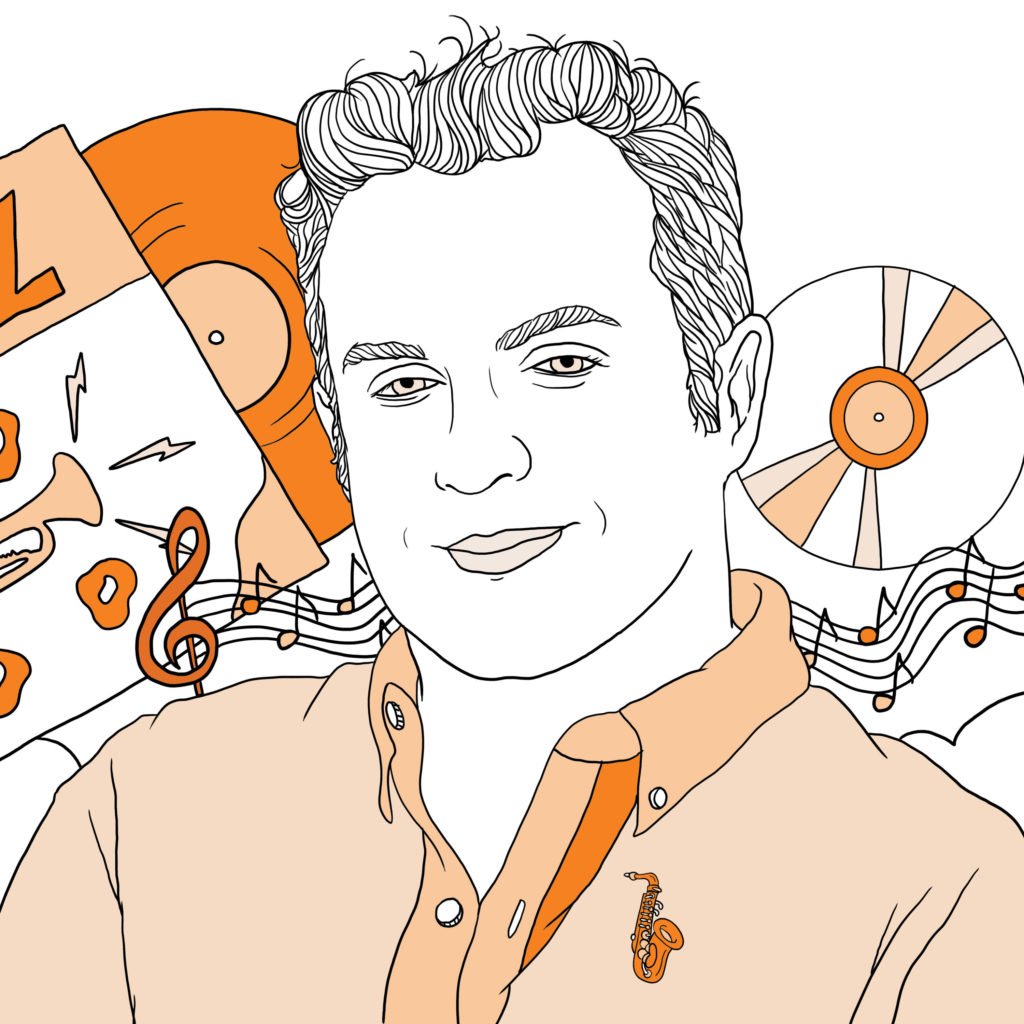
The Jazz Detective
Zev Feldman
Lost music? This dogged producer is on the case.
Montgomery Village has never been known as a jazz hotbed. But one of its townhouses contains a musical secret: an enthusiastic dude who’s one of the world’s top trackers of unheard recordings. For more than a decade, Zev Feldman has been uncovering lost sounds from the likes of Bill Evans, Albert Ayler, and Wes Montgomery; tracking down rights holders so people get paid; and producing the music for re-lease, usually in lavish packaging. A Grammy-nominated producer, Feldman is co-president of the renowned label Resonance Records and cofounder of another called Elemental Music; he also works with Blue Note and other imprints and has two labels of his own, Deep Digs and Jazz Detective. He does it all from his album-and-memorabilia-packed home, near where he grew up. “My neighbors and I are very friendly, but no one really knows what I’m doing,” says Feldman, who has ten new releases coming out in April. “I’m literally producing for five record labels. I just think it’s really freaking cool that I do that here.”

The Bookshelf Curator
Chuck Roberts
The man to call when your shelves need to make a statement
A service that curates book displays for things like Zoom backgrounds might sound like a pandemic-born enterprise, but Chuck Roberts has been helping people put their best bindings forward for decades. While he’s mostly a used-book seller–he has three Wonder Book stores in Maryland and roughly 5 million titles on hand–he also runs a service called Books by the Foot. He’ll source, say, an entire wall of robin’s-egg-blue books for an interior designer or a collection of cookbooks and murder mysteries for Hannibal Lecter’s lair in the TV series about the fictional serial killer. Then there are the video-chat mises-en-scène, which are similarly personalized. “People want books that reflect their taste,” Roberts says. “You don’t want anything embarrassing or silly, like Danielle Steel romances or something.”
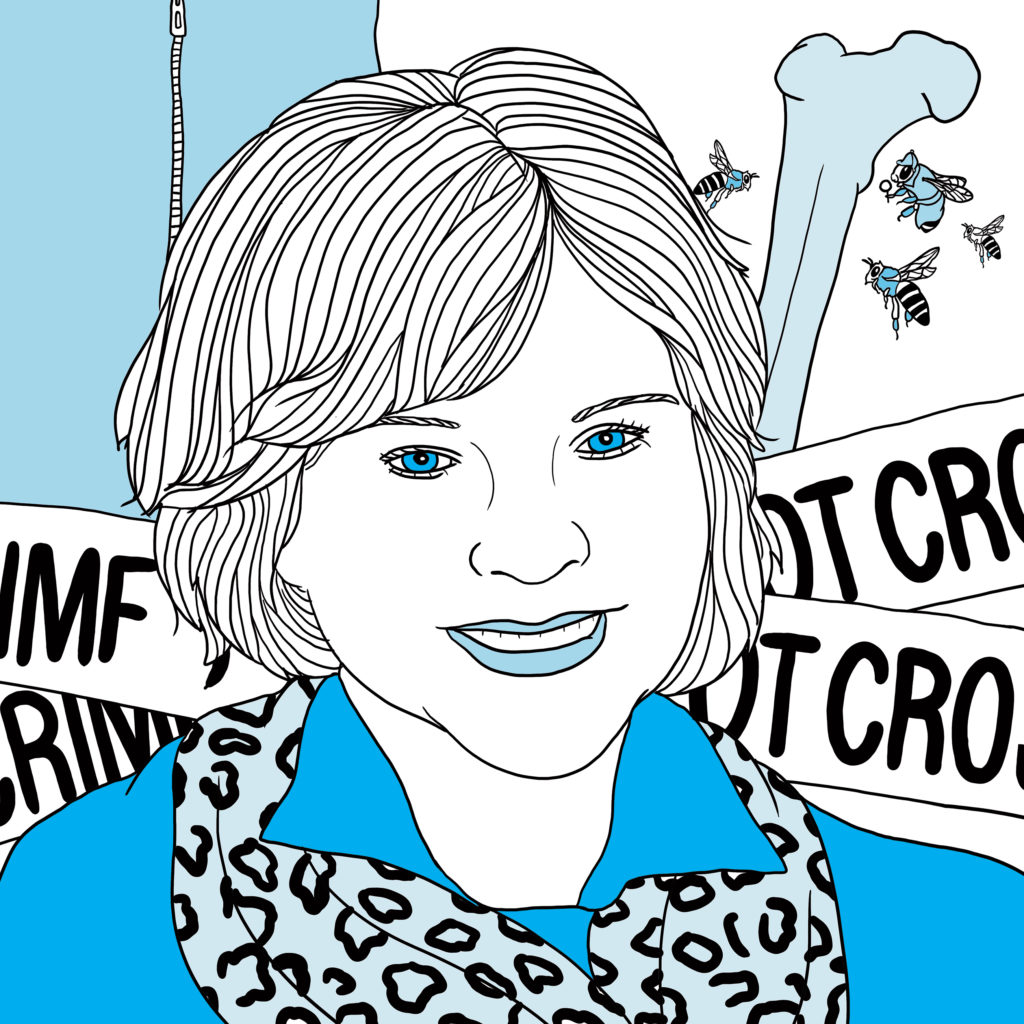
The Body Woman
Mary Ellen O’Toole
Studying new ways to investigate homicides
A murder. A body. Watch TV and you know what’s next: Detectives comb the scene, run some labs, and voilà!Case cracked. Except real life is more complicated. “We don’t really understand that much about human decomposition,” says Mary Ellen O’Toole. The director of George Mason’s forensic-science program, O’Toole heads the school’s “body farm,” one of a handful of facilities in the country that study cadavers the way they’re often found–hidden, in the middle of nowhere, left for weeks or years. On five wooded acres in Manassas, researchers and students are using drones, radar, and even honeybees that pick up chemicals created by decomposition to locate and glean more clues from human remains. “A lot of of-fenders think they are much smart-er than law enforcement,” says O’Toole, who previously profiled serial killers as an FBI agent. “Can they take every precaution not to make a mistake? Absolutely not. It’s just that the science hasn’t allowed us to catch up yet.”
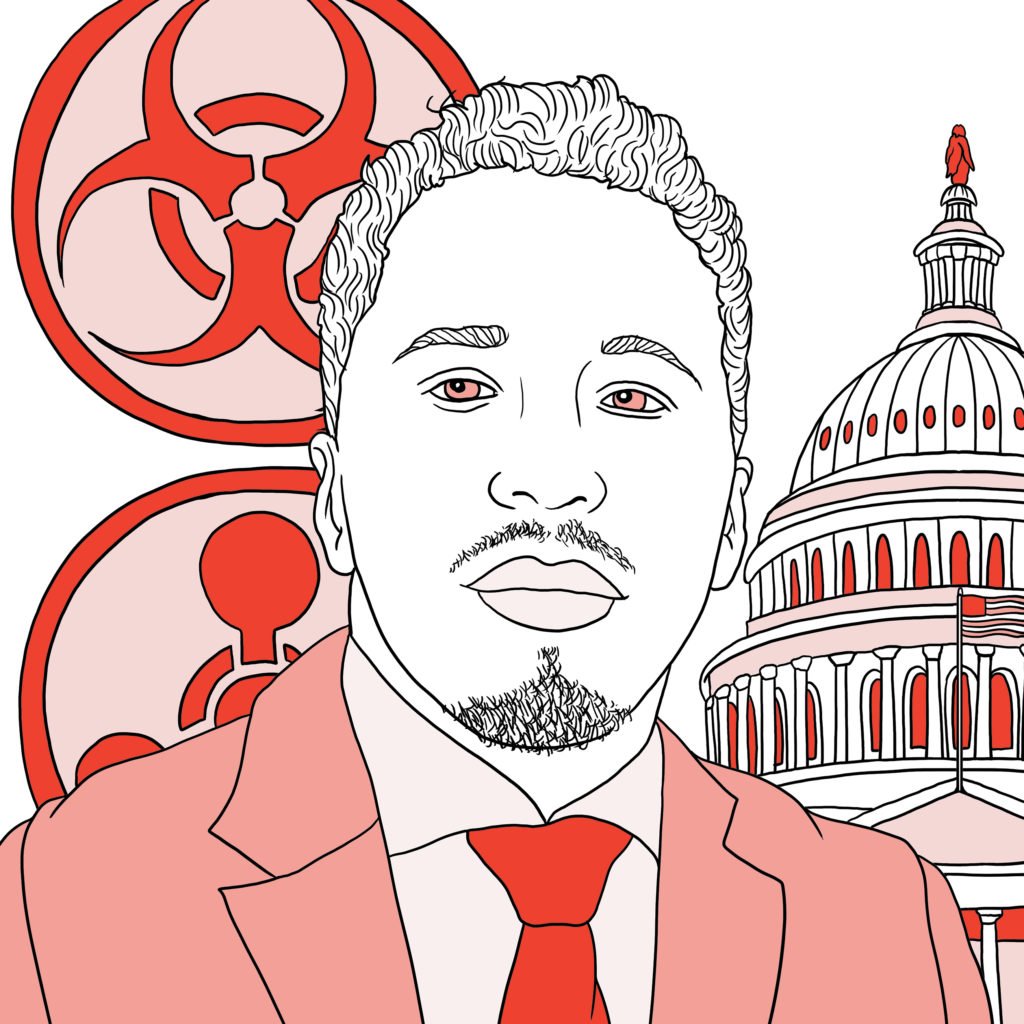
The Master of Disaster
Donell Harvin
Worst-case scenarios are his specialty
Donell Harvin has a tough time explaining what he does–“subjectmatter expert in homeland security” is the phrase he uses, which sounds pretty dry. Actually, his job is to have deep knowledge of some of the world’s most harrowing threats: biological weapons, domestic extremism, nuclear fallout. Harvin teaches at Georgetown and works with organizations including the United Nations and INTERPOL. In any given month, he might appear on MSNBC to discuss terrorism, fly to Ukraine to provide training on weapons of mass destruction, and work with Puerto Rico on natural-disaster response. Harvin started out as a New York City paramedic, but after responding to 9/11, he went to school to study terrorism. Next came several prominent roles in disaster management, putting him at the epicenter of some of this century’s most traumatic events: Sandy Hook, Hurricane Sandy, Covid, and January 6. Asked what keeps him up at night, Harvin jokes that it’s his dog snoring. “I don’t want to say I’ve seen it all,” he says, “but if I haven’t seen it at this point, I really don’t want to.”
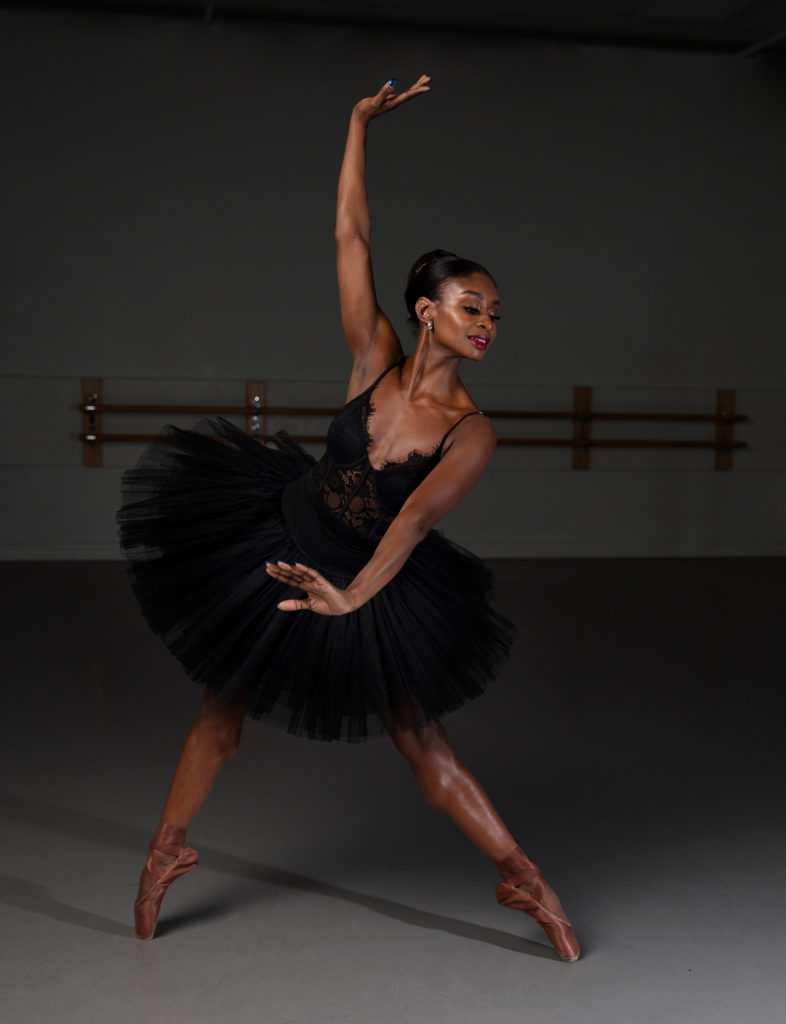
The Dancing Queen
Ashley Murphy-Wilson
Producing onstage grace through behind-the-scenes grit
Ashley Murphy-Wilson has a scar on her chin, the result of jumping on–and falling off–her bed as a child. That led her mom to start her in ballet, along with gymnastics, swimming, tennis, piano, and singing lessons. “I had something to do every day after school,” she says. “Because I have a lot of energy.” Now dancing with the Washington Ballet, Murphy-Wilson brings the same vibrancy to the stage–and the same physicality to a gig that’s surprisingly similar to pro sports: late nights, long road trips, hours of unseen training, and lots of aches and injuries. “People think this isn’t a sport, because we make it look easy,” she says. “I don’t get to grunt and hit people, but my body’s going through the same things.” The payoff? Murphy-Wilson has performed at the Kennedy Center and the White House, in a Super Bowl ad, and as a visual clue on Jeopardy! “I think there’s a recording of that at my mom’s house,” she says. “And we still get residual checks from it, which is pretty cool.”

The Dog Marshal
Amy O’Connor
Commanding Walter Reed’s therapy-dog unit
A few of Amy O’Connor’s most respected and decorated colleagues at Walter Reed National Military Medical Center are two-star major general Goldie, chief petty officer Sully, and Marine Corps corporal Biscuit. A social worker, she manages the hospital’s canine program, working with its eight therapy dogs and 12 human handlers to brighten the days of wounded servicemembers and other patients who may have few reasons to smile. O’Connor cofound-ed the program 17 years ago after getting the idea to bring a service dog to visit a family in the ICU. “I was like, ‘Wow, this is really powerful,’ ” she says. Bestowed with honorary ranks, the dogs are even-tempered, purpose-bred, and trained for their work–which includes helping people with brain injuries as they relearn motor tasks, playing with hospitalized veterans’ kids, curling up in bed with lonely patients, and helping staffers de-stress. “There is not a patient or staff member that asks for a visit that we do not do everything in our power to get to yes for,” O’Connor says. “We work to improve the human experience here.”
Back to Top
The Coolest Thing About My Job
Past and present Washingtonians of the Year tell us what makes their jobs cool

Mirah Horowitz
CEO and founder, Lucky Dog Animal Rescue
“Puppy kisses!
There’s just something special about an eight-week-old puppy, and I get to see so many without actually having to adopt them all myself.”

Bob Woodward
investigative reporter and author
“You get to ask the questions and the follow-ups.”

Shawn Yancy
NBC4 news anchor and founder, Giving Foundation for Women and Children
“Getting to meet so many incredible people, whether it’s the President of the United States or the lady at the grocery store who says, ‘I’m watching you every night.’ That’s the best.”

Carla Hayden
Librarian of Congress
“Nothing beats seeing someone’s jaw drop when they look at the draft of the Declaration of Independence or tear up when they read Rosa Parks’s letters or start humming when they look at Leonard Bernstein’s sheet music.”

Mike Locksley
University of Maryland head football coach
“Every year, I get a new batch of 18-to-22-year-olds in the locker room, and I have to keep adjusting to the times as they come in. So I’m kind of like Benjamin Button—I’m aging backwards.”
Back to Top
DC’s Least Cool Jobs
These familiar gigs may be necessary, but that doesn’t mean they’re beloved

Consultant
Look, we know you’re out there working hard to deploy systems, align strategies, integrate action plans, streamline processes to create new synergies, and otherwise deliver, uh, deliverables. Oh, and all those pretty PowerPoint decks? They’re certainly not writing themselves. Still, the existential question posed by the Bobs from the movie Office Space–themselves a pair of consultants!–applies: What would you say you do here?
Sidewalk clipboard holder
You took out student loans, immersed yourself in campus activism, earned a liberal-arts degree, and followed your heart to the most influential city on the planet, determined to make the world a better place by winning over hearts and minds . . . only to stand outside a Sweetgreen in a brightly colored T-shirt, hoping against hope that passersby will take your brochure and listen to your spiel–or, barring that, at least look up from their phones for a fleeting moment of eye contact. There’s participating in grassroots politics, and then there’s being a blade of grass shooting up from a crack in the concrete, only to get stepped on, over and over, by strangers in a hurry to be anywhere else.
Lobbyist
Quite possibly the only folks less respected than the politicians they seek to persuade, lobbyists manage a rare trifecta: despised for what they do (influence legislation), how they do it (out of sight, mostly), and what they represent (a society that often puts the needs of a powerful few over those of the powerless many). Of course, it’s also true that lobbying can help accomplish good things, that a government people can talk to is better than the alternative, and that in the end, they’re all special interests. So are lobbyists . . . actually cool? Maybe they need to make a better case for it.
Back to Top
The Washington “Cool Job” Matrix
A visual guide to how some of our city’s most coveted and familiar gigs compare with one another
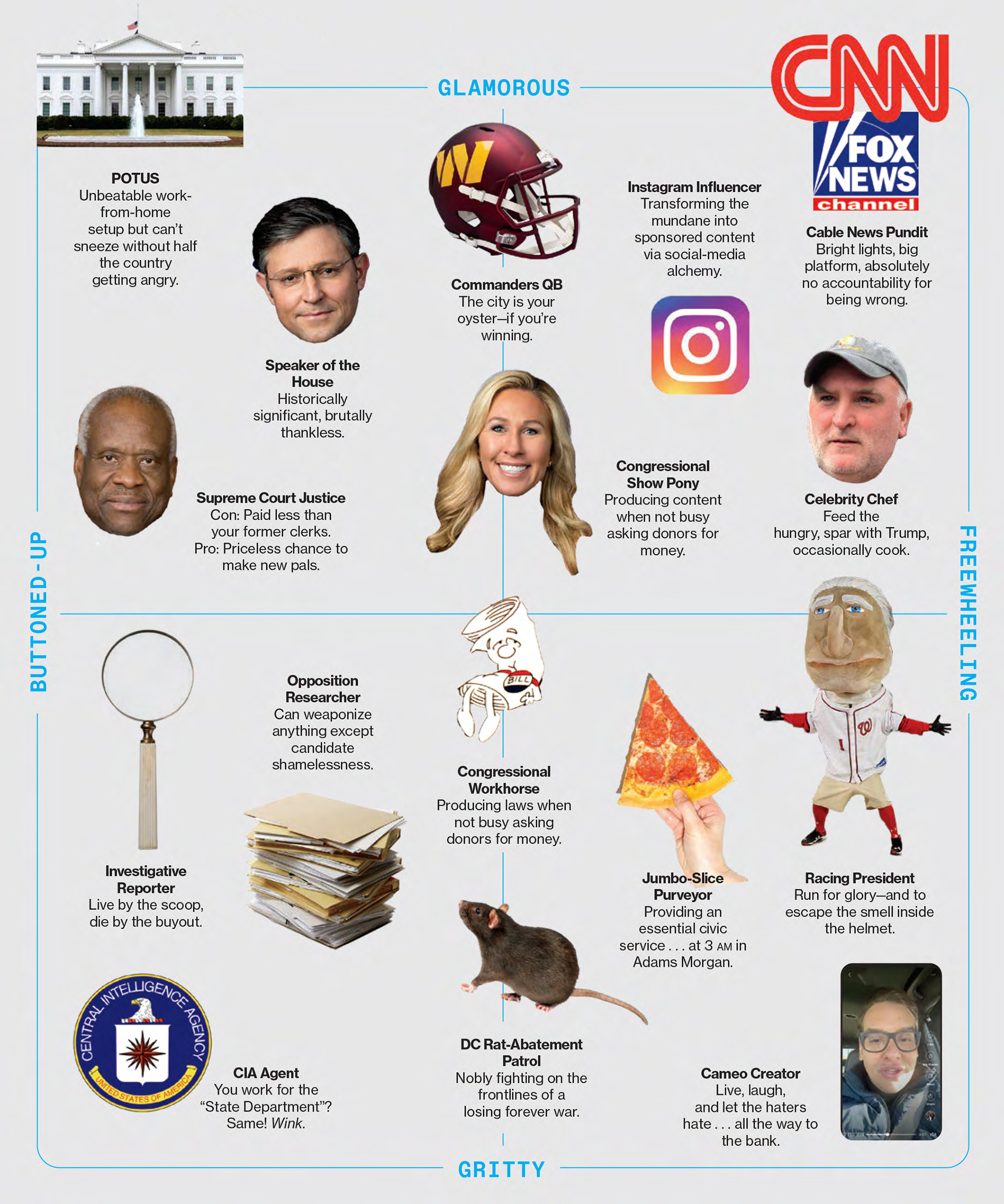
Photograph of Andrés by Evy Mages.
Photograph of magnifying glass, documents, and rat by Getty Images.
Photograph of pizza by Pexels.
Photograph of Racing President by Pete Souza/Obama White House Flickr.
Cartoon of Congressional Bill Courtesy of Everett Collection.
This article appears in the March 2024 issue of Washingtonian.
